

Everest Base Camp Trek in September

In September, as the monsoon passes, the autumn trekking season begins. The sky will be clear and perfect for trekking this time of year. Although the weather is cooler than in the spring (about -10°C to -12°C at base camp), the days are wet at first but the views are breathtaking. The rainy season may linger a little longer while going to Everest base camp trek in September , resulting in more precipitation on the journey. However, the temperatures are usually warm at lower elevation & cooler at higher elevation.

The lush & green landscapes in the lower sections of the trail are breathtaking. The monsoon rain swept and cleaned away all of the pollution in the region, making the picture looking incredibly lush and green.
Although the continual humidity in September may obscure some mountain vistas, the amazing views can still be seen in the morning. The monsoon has passed by the middle of September, and the popular Everest Base Camp trek becomes less busy than in October and November.
Actually, predicting climatic changes in the mountains is difficult because the weather is completely dependent on the seasonal patterns in the northern hemisphere. If you choose to come on this trek, there is no season or weather that may dampen your ambition. With the proper EBC trek preparation and gear, you can go at any time of year.
Everest Base Camp Trek September Weather
In September, at higher up mountain region, in the evening and early morning will be cold but, not as much like winter season. The Everest base camp trek in September has quite comfortable weather with neither too hot nor too cold. Until half of the September, you’ll caught by some little rain & this doesn’t happen very often. However, the weather is pleasant and clear in September.
The temperature during the day ranges between 15°C to 20°C and temperature falls in the night between 4°C to 6°C. Although, the climate and weather temperature are determined by place of height. During the bright days, temperatures at higher altitudes above the 4000 meter can ranges from -1°C to 12°C. And, the night temperature ranges from -10°C to -5°C (above 4000 M).
Typically, the monsoon season in Nepal last from June until early September. In fact, this month is not as wet as July/August, rain is still possible. The rainfall only for few days in the mid time of months. That may impact to the Lukla flight that runs from Kathmandu or Ramechhap. However, the rain stops virtually by end of the September. Due to the Global warming the weather of mountain has also big impact.
Remember, trekking to Everest Base Camp is not a hot trip, so you don’t need any warm gear. While trekking to EBC every time of the year you need right warm & comfortable gear. The EBC trek in September is pleasant time to visit. Though, you may not encounter lot of tourist along the route in this time of the year. The normal temperatures fall below 0°C only in higher height above 4200 M or closer to Everest only at evening & morning. In September, the average low & high temperature of Tengboche is 5°C to 12°C.
Everest Base Camp Trek Temperature in September
Everest bae camp trek in september: advantage & disadvantage.
September is the best time to visit Nepal. Because this is the post monsoon season, the sky is usually remain blue and clear and air is pure to breathe. Feel privileged if you intend to hike this time. There will be fewer people around and you will have more time to spend in nature. You will have complete control over the path. The trail slowly starts to get busy with the starting of Autumn season. Until the mid of September, the trail does not get some much busy. But, after half of the month the trail start to increase with number of trekkers along the route. Every season of month have benefit & drawbacks that inspired to visitors which are as follows.
Disadvantage
Suggested everest region trek route in september.
While September marks the beginning of Nepal’s busy autumn season, the trails do not become very congested until October. After a monsoon break, most trekking route in Everest region are reopens for the adventure trekkers.
Everest Base Camp Trek : This trek is very popular for almost every adventurer in the world. This trek not only offers Mount Everest’s natural beauty, but it also teaches you about the Sherpa people’s rich historic culture and traditions, as well as the Tibetan Buddhist faith. Monasteries, gompas, and prayer wheels are examples of ancient architecture and sculpture that make you forget about the difficulty of the walk.
Gokyo Lake Trek: In the Everest region, Gokyo is an attractive and unique trip. Your trek will be enriched by the Gokyo valley, which is adorned with freshwater lakes with awesome glaciers. This trip provides breathtaking views of majestic peaks and Nepal’s largest glacier, the Ngozumpa Glacier. It is appropriate for people who are unable to complete the Everest Base Camp Trek because of inclement weather.
Everest Base Camp Helicopter Tour : This type of tour is ideal for people who don’t have the time to trek for 12 to 14 days. People who are physically disabled as well as the elderly can take a 3–4 hour helicopter flight to EBC by helicopter. This tour provides the stunning peaks, including Mt. Everest, Lhotse, Amadablam & Thamserku etc. as well as other most breathtaking vistas can be seen during the trek. The helicopter tour is fantastic way to see the aerial view of Himalayan Land Scape.
Everest Base Camp Trek September Packing List
The weather in the mountains is unpredictable, therefore you must plan ahead of time. Rainfall is expected in the early days of September. To avoid from getting wet, bring a rain coat or poncho and water proof backpack. Remember, the Everest base camp trek is a high-altitude trek, you should have basic knowledge about the packing list according to season.
Don’t forget to carry enough extra socks. Because you need some spare socks for the reason that you don’t have to trek with wet feet. And make sure you have other changing clothes after your arrival at the lodge, so you don’t have to sit around in the damp clothes. Light woolen merino clothes are perfect to keep you warm even if you are wet.
Another is that it’s a good idea to bring your own sleeping bag for the Everest base camp trek . Although most tea houses provide adequate blankets, they are not always clean. Therefore, it is recommended to carry them by yourself. As a result, I hope that this post will assist you in making decisions and preparing.
The EBC Trek Packing List for September is as follows:
Backpack: A backpack with a capacity of 50 to 60 liters is highly suggested. Make sure it’s appropriate for your body type and read reviews online before purchasing. You may like to read more about the backpacking for the Everest trek.
Hiking or Trekking Boots: It’s critical to invest in a pair of hiking boots that fit properly. Ankle boots are a great choice. Read on for more information about boots for the Everest Trek .
Down Jacket: Bring a genuine goose feather down jacket if possible. Jackets that are comprised of synthetic materials are not as light as they appear. Read the jacket for the EBC trek.
Rain Jacket: It must be wind and rain protection and can also utilize during the day. Detachable layers are especially useful.
Flip Flop or light Shoes: After a long hour of trek in hiking boot, you may require light weight flip flop or light shoes to change & wear in the lodges. Especially in late afternoon or in the morning.
Micro Spikes: If you’re travelling over one of three high passes, micro spikes are good. On slick surfaces, these light spikes are useful.
Trekking Poles: However, it is always useful to use on more difficult up and down paths. Purchasing a pole is the best and most cost-effective option.
Water Bottle & Purifier: UV filters, like the SteriPen, and also purifying drops and tablets, are effective. If using drops or tablets, bring your own non-plastic bottle.
Sunglasses: To protect yourself from UV rays, make sure they’re polarized.
The Other Essential Packing List for the EBC Trek in September
Sleeping Bag: Although most hotels will provide blankets, it is still necessary to carry your own sleeping bag for the Everest base camp trek .
Hat: For the evenings and early mornings, a warm beanie type hat is recommended. Sun hat for day time, make sure it has a wide brim to cover the face & neck.
Gloves: The best gloves are those that are waterproof. It’s even better if you can get ones with detachable layers.
T-Shirt: Long-sleeve shirt is good rather then short sleeve shirt because skin can burn due to intense cold, sun & wind.
Thermal Wear: It’s a good idea to bring some thermal wear during the Everest Base Camp Trek.
Trouser Pants: For colder days, thick, fleece-lined trousers are suggested & lightweight trousers for sleeping.
Socks: Look for ones that have more insulation and are designing specifically for trekking.
Medical Kit: Don’t forget to carry your own medications from home. Common problems like dehydration, diarrhea, fever, headache, tonsillitis can occur during the trekking period.
Bio-degradable toiletries: Toilet paper can buy along the route. Other things, better to buy in cities.
Nepal Festival & Events in September
Indra Jatra (Procession of King of the Gods): This eight-day festival formally begins on the twelfth day of the waxing moon in September. Indra Jatra is Kathmandu’s largest religious street festivals in Nepal.
This eight-day event is known as Yen Ya and is predominantly observed by the Newar populations. Indra, the Hindu god of rain and heaven, is honored throughout the event. Indra Jatra, on the other hand, is a festival that is followed by both Hindu and Buddhist believers. Basantapur, or Kathmandu Durbar Square, is the focal point of the celebrations.
Kumari Jatra (Chariot procession of Living Goddess): Kumari is worshipped in grand manner in the occasion. Kumari Jatra is a festival in which the living gods Ganesh and Bhairav, as well as goddess Kumari, are drawn through the city in chariots. She steps out of Kumari Ghar, from her house in the square, on this day. The chariots are carried from Basantapur to other parts of the city so that people can see the event and worshipped.
Dashain Festival: Dashain, Nepal’s most important yearly event, occurs in late September and some years, early October. Dashain is predominantly a Hindu celebration and is not much celebrated in the Everest region due to its Tibetan Buddhist influence. But, Dashain is widely observed in the hilly & Terai region by other Nepali ethnic groups.
It is crucial to arrive a day early in Kathmandu before the Dashain celebration day. At this time, much of the city closes down, fewer restaurants and shops open, and taxis are harder to get until afternoon. Remember, Dashain festival is like Christmas day in American & Western countries.

Everest Base Camp Trek Details
Remember trekking to Everest Base Camp is not a hot trip that you don’t need any warm gear. While trekking to EBC every time of the year you need right warm & comfortable gear.
You may also like...

Everest Base Camp Trek in October

Everest Base Camp Trek In March

Best Boots for Everest Base Camp Trek
Leave a reply cancel reply.
Your email address will not be published. Required fields are marked *
WhatsApp Us For Quick Response

- Privacy Overview
- Strictly Necessary Cookies
This website uses cookies so that we can provide you with the best user experience possible. Cookie information is stored in your browser and performs functions such as recognising you when you return to our website and helping our team to understand which sections of the website you find most interesting and useful.
Strictly Necessary Cookie should be enabled at all times so that we can save your preferences for cookie settings.
If you disable this cookie, we will not be able to save your preferences. This means that every time you visit this website you will need to enable or disable cookies again.

Eagle Eye Treks And Expeditions

Everest Base Camp Trek in September

The Everest Base Camp trek in September offers a chance to trek in a peace. There is a low crowd season and the temperature is neither too hot nor too cold. The skies are clear and offer magnificent views of the Himalayas.
September marks the beginning of autumn. With the end of rainy monsoon and the winter still months away, the September weather is perfect for trekking. It is among one of the best times to trek in Nepal.
Everest Base Camp trek is a very popular destination for many travelers. And why wouldn’t it be? It is an amazing getaway to the mountains full of breathtaking scenes. The trek offers you a chance to find your inner peace.
Everest Base Camp trek is a delight all year round. But, the Everest Base Camp Trek in September may be your one chance to see the true colors of the mountains. And the most beautiful sunrises and sunsets after the monsoon shower are simply awesome.
The monsoon is almost over by late September and autumn is just around the corner. Autumn brings about wonderful changes like the changing color of the leaves, the clear blue skies, and mesmerizing landscapes.
The hotels and tea houses are up and running, and the trekking paths are clear and peaceful. Only sudden downpours could bother some trekkers who aren’t ready for it.
But, with a bit of preparation, the monsoon will leats affect your trek. Rather, the rain-washed sky will provide you a chance to see the mountains in all their magnificent glory.
Here is a more detailed guide on what to expect if you are thinking of trekking to the Everest Base Camp in September.
Weather of Everest Base Camp Trek in September
The Everest Base Camp trek in September has both the elements of monsoon and the autumn. In the first few weeks of the month, the monsoon rain is still prevalent and as so you may experience a few unexpected downpours.
The average temperature during the day is warm in the lower areas of the trek with an average of 15 to 20 degree Celsius. But the temperature does begin to drop as you ascend to higher altitudes with an average of 5 to 10 degree Celsius.
The average temperature during the night gets colder. The temperature drops below the freezing point at high altitudes. It reaches about -2 to -5 degree Celsius.
During the trek, you may find the temperatures to be warm in the day time so there shouldn’t be a problem with the weather except for the occasional rain.
In the later weeks of the trek, however, the temperature gradually drops. But the monsoon rain stops and autumn begins to peak. But you must always be prepared for the unpredictable weather condition of EBC .
Do you have any question or Confusion?
- Full Name *
- Your Email *
- Contact No.
- Nationality
- Your Message *
Accommodation for Everest Base Camp Trek in September

The Everest Base Camp trek in September offers a wonderful opportunity for those seeking tranquility. As in the early weeks of September, overcrowded tea houses or hotels is not an issue.
These teahouses begin preparing for the peak seasons to come so you will have all the benefits. They even offer discounts during this time so you are in for a treat.
There are three to five-star hotels in Namche Bazaar. There are other hotels as well which you may choose from. They will provide you with the basic necessities such as blankets, extra pillows, towels.
In places such as Namche Bazaar and other tourist hubs, you will have the facilities of a western style toilet. But, you will have to learn how to use the squatting toilet as you ascend. As only those are available in the higher altitudes.
You may or may not get facilities of hot water in some of the places, but they will happily provide you with some for a few dollars if you ask.
However, you should not expect much of the facilities as you climb higher. The places you will stay at do provide basic facilities but there are no big hotels just small teahouses.
Food for Everest Base Camp Trek in September
The food available during the trek is almost the same as the food available during the other months. As you ascend higher there will be fewer choices and steeper prices of food.
You should definitely bring some foods with you such as dry snacks. You have to make sure you are having a well-balanced meal so that you have enough energy for the challenging trek.
The most preferred and easily available food throughout the trek is the traditional Dal- Bhat. This meal is a well-balanced meal served with rice, lentil soup, and some veggies. It provides enough energy as well as the nutrients required for your body.
But, you need not worry as meals such as porridge, pancakes, fries, pasta, momo( Nepali dumplings) etc as they are also available on the menu in most places.
The food at Namche Bazaar, however, is something you should not miss. They have amazing bakeries as well as a wide selection of dishes which are all delicious. As Namche Bazaar is a hub for tourists from all around the world you will get to experience different flavors to indulge in.
It is also recommended that you keep yourself hydrated throughout the trek with at least 1-2 liters of water. Bottled water is easily available but may be a bit more expensive in the higher altitudes.
Festivals You can Enjoy During EBC Trek in September
Nepal, as you may know, is full of people who are from different religions and cultures. So, when you are here, why not observe the unique festivals?
The main two festivals that you can enjoy in the month of September are Teej and Indra Jatra.
The festivals are not widely celebrated in the Everest region yet there are grand celebrations of them in Kathmandu. So, you can plan your trek accordingly and enjoy the festivals.
The festival of Teej is mainly celebrated by women. They put on their best red outfits and worship Lord Shiva in order to ensure the safety and longevity of their children and partners.
If you want to take the full experience you can not miss visiting the Pashupatinath temple.
Indra Jatra
Indra Jatra is a 7-day festival observed only in the valley. It is a cultural festival that began in the medieval age. It is the biggest celebrations in Kathmandu.
If you want to enjoy this pompous affair, it is best to plan your treks consulting the lunar calendar of Nepal. Allow us to plan it for you.
Highlights of Everest Base Camp Trek in September

Moderate Temperature
The temperature is not too cold as the winter is still a few months away. And during the day time, it is quite sunny and warm. The nights do get cold but less than the winter months.
Clear Skies
The monsoon is almost gone so the skies are very clear. This allows for amazing views of the Himalayas as well as the landscape.
The Everest Base Camp in September offers fewer crowds. Many trekkers start to come to Everest region from October. So the trek is perfect for people who are searching for a peaceful trek.
Great Deals on Accommodation
The low number of trekkers in September means there are many great deals on prices which is always a good thing. Plus, you do not have to stand in the queue for the food and accommodation.
Frequent Flights
The suitable temperature and weather of late September support regular flights to Lukla. The clear weather offers the best visibility. So, there are lesser chances of flight cancellations and delays.
Difficulties of the Everest Base Camp Trek in September
The Everest Base Camp is a challenging trek in itself no matter which month you travel in. The Everest Base Camp Trek in September may also cause some difficulties like
Problem of Leeches
The monsoon season attracts many leeches in the trekking trail. This may be a problem that can be easily avoided if you carry anti-leech sprays and/or ointment.
You may also find the mosquitoes annoying in the lower part of the trekking trails. But they won’t be a problem as you ascend to higher altitudes.
Unpredictable Rain
Even though monsoon is almost over, during the early weeks of September you may have to experience some unexpected downpours. You need to trek with a great pair of waterproof trekking shoes along with some rain jackets and trousers.
A sudden change of altitudes may become a problem and cause altitude sickness. You should make sure you plan your trek and include some days to rest and acclimatize. As you will be ascending to the altitudes above 5000 meters at Kala Patthar the risk of altitude sickness is common. So, you must walk cautiously.
You will also be less likely to get affected by altitude sickness if you keep yourself hydrated. Also, be sure to avoid things such as sleeping pills and/or alcohol.
Packing List for Everest Base Camp Trek in September
To ensure you have a safe and sound trek you should make sure you pack accordingly. Here is an outline of things for EBC trek in autumn that you should not miss out on.
While packing you should keep the monsoon rain in mind. A pair of rain jacket and trousers are a necessity during this trek.
In addition to those, as the paths are quite muddy and slippery during the first few weeks of September. Be sure you back trekking shoes with a good grip.
You will face humid weather, be sure to pack breathable pieces of clothing. And as the elevations increase the weather tends to get really cold. So warm clothes are also necessary.
It is also recommended to carry light, wind jackets suited for monsoons. This is to make sure you remain dry and comfortable during the treks.
Some accessories that you should not miss out are well-polarized sunglasses and a wide-brimmed sun hat. These will make your trek during the day more comfortable.
- Waterproof backpacks (will protect your personal belongings and important documents from the rain)
- Sleeping bag with a liner (for windy and cold nights)
- Trekking Poles
- Torchlight and extra batteries (for trekking during the early hours)
- Water bottle
- Insect repellant sprays, bands or ointment (mosquitoes and leeches may bother you)
Some Useful Tips for EBC Trek in September

Check the Weather Forecast
Do keep track of the weather, especially for flight timings. The monsoon rain may cause flight delays or cancellation.
Have a Flexible Schedule
You might want to extend your trip if the mountain views are not clear at times. Having a flexible schedule is a very important thing in these type of situations.
Hire a Guide and a Porter
Hiring a porter and a guide is a good idea as it allows you to travel hassle free and be safer. Besides, having someone carry your luggage at high altitudes where there is a high chance of altitude sickness is a good idea.
Get a Travel Insurance
You will need this in case you need any medical attention or for the immediate helicopter rescue. Forgetting or losing your baggage is also a possibility. So, it is in your best interest that you get travel insurance from your home country.
The Everest Base Camp trek is great all year round. But the Everest Base Camp trek in September is special. It is a shoulder month and has the quality of both summer and autumn.
Autumn sneaks in by late September and the weather only gets better.
For peaceful trekkers, early September should seal the deal. It is quite peaceful and serene this time of the year. Yet, there is nothing you will have to compromise in. And the weather in the capital is just spectacular in September.
It’s not just the temperature that is nice, there are fewer crowds and great deals on accommodation. Despite some of the difficulties like the drizzles and insects which are easily resolved, Everest Base Camp in September is a treat.
If you want to book your trek to Everest Base Camp in September or any other months. Or if you have other inquiries feel free to contact us .
- Nationality *
You may also like...

Everest Base Camp Trek 12 Days

Everest Gokyo Ri Trek Cost

Everest Base Camp Trek Deaths

Why Trekking to Everest Base Camp in September ?
Raj kumar basnet.
- Last Updated on Dec 30, 2023
Trekking to the Everest Base Camp is best done in spring and autumn. We're all well-known of that fact by now, but among those two seasons, which month is the most favorable? Well, it depends on several factors, primarily your schedule, and preference. While all 6 months are best for trekking to EBC in their own ways, September has its own charm to attract trekkers to the Everest region.
September is the official beginning of autumn in the Everest region and all over Nepal, as the monsoon ends when September approaches. The monsoon cleans up the atmosphere with a long rainy season, enhancing the ambiance of the Everest region with a crystal clear view of the verdant hills and snow-covered mountains. The scenic views of the towering peaks during this period are amazing. The green hills and the pastures look lovely.
Let's be honest. Trekking in the mountains in really cold weather isn't practical. And you wouldn't want to go on a hiking journey in too much heat. You should also steer clear of any rain as well. What month will solve all of these issues, then? September! The weather in September is pleasant and suitable for your trekking plans. The mild daytime temperature is suitable for day hikes.
You can enjoy the alluring vistas of sugar-coated peaks, including Mt. Everest (8,848 m), Lhotse (8,515m), Nuptse (7,861m), Ama Dablam, etc., without any obstacles. You will also love the unique culture and traditional practices of the Himalayan Sherpa people, especially the festivals celebrated during the month of September. The lifestyle and hospitality of the Sherpas are humbling as well.
In this blog, we'll find out why September is the best month for you to plan your next EBC trek in detail. Please follow through to learn more about the trek to Everest Base Camp in September .
Table of Contents
Highlights of everest base camp in september.
- Stable weather and pleasant temperature conditions
- Crystal-clear views of the impressive mountains, high hills, and snowy peaks
- The unique culture, traditions, and festivals celebrated by the Sherpa people of the Khumbu region
- Fewer chances of flight delays and cancellations for Lukla
- Good availability of accommodation on the trail
- Less-crowded trails offer solitude while trekking
- The diverse flora and fauna of the Everest region flourishing in September
What is the Weather and Temperature in the Everest Base Camp like in September?
The weather in September is one of the nicest aspects of the EBC trek. For trekking in the Himalayas, the weather in September is excellent. It's not too cold or too hot. At this time of year, the skies are clear and devoid of humidity. However, early weeks may have a small risk of precipitation, while there are no prospects of snowfall in September.
Post Monsoon Weather
September arrives right after the monsoon ends officially. If you are trekking in September, you will experience post-monsoon weather. During early September, it might rain at the lower elevations. The trails might get wet and slippery. While trekking to EBC in September, you must carry rain protection gear such as a raincoat or even a poncho. In some years, the monsoon continues till September. Do not forget to pack warm gear for nights. Nights in September are cold, while days are warm.
Stable Weather
The weather in late September is much more stable. The monsoon rain washes away the dust and dirt from the atmosphere and nourishes the vegetation. The hills, forests, and grasslands look greener than ever. The skies become cloudless and blue. The distant vistas and the panorama of snowy peaks look more attractive. The wind is mild and enjoyable.
Pre Winter Weather
At Everest Base Camp, the month of September (especially late September) experiences pre-winter weather. The daytime temperature is mild, so the days are warm. However, the nights are cold and get colder day by day. You will need warm clothes for the nights while trekking to the Everest Base Camp in September.
Everest Base Camp Temperature in September
In the Everest region, there is always a huge difference between daytime and nighttime temperatures. At the base camp, temperatures in late September are lower than in early September. Daytime temperatures are mild. However, the night feels chilly. The temperature at night can drop even to zero degrees or below. The temperature at Everest Base Camp in September ranges between 8 to 15 degrees in the daytime, while the nighttime temperature ranges between 7 to -1 degrees.
Note: Get some warm clothes for nights for your EBC trek in September. We also advise you to carry rainproof gear.
How's the availability of Accommodation, Food, and Drinks on the EBC trail in September?
Since September marks the beginning of autumn (peak trekking season), the EBC trails are less crowded as people are just starting to show up. This means you will have easier access to accommodation and food.
Accommodation in the Everest Base Camp route
The trek to the Everest Base Camp is a popular tea house trek route. You will find plenty of tea houses and mountain lodges for accommodation. Many people love to go camping during September. It is a good time for camp trekking as well. Similarly, there are also high-end fancy hotels providing 4 to 5-star services in the Everest Region. You can choose your accommodation according to your liking.
The EBC trail isn't as busy in September as it is just the beginning of the autumn season. So, it will be easier for you to get rooms for staying at the teahouses and hotels. You will have lots of choices for stays. Early booking isn't mandatory for the base camp for Everest Trek in September.
The tea houses en route are basic and provide decent services. Do not expect big rooms and high-end facilities. In general, they provide a single room on a twin-sharing basis. But in September, due to less crowd, you might also get a single room. On the other hand, the big hotels facilitate you with spacious rooms with comfortable beds and attached washrooms.
Note: Nights are cold. So, carrying a sleeping bag helps. The tea houses will provide you with blankets anyway. You can ask for some extra blankets in September.
Food and Drinks available on EBC trekking trail
The higher you trek, the fewer will be options for food. You will eat three meals daily during your Everest trek: Breakfast, Lunch, and Dinner. The tea houses where you stay overnight will serve you dinner and breakfast. You will eat lunch at some lodges or tea houses en route.
The food menus have limited cuisines at higher altitudes, given the situation (food has to be carried in helicopters or by horses or potters). They serve some of their local dishes. Most of the foods include cereals, rice, and flour products. You can also find some international cuisines on the menu.
Most tea houses have similar menus. You can eat bread, pancakes, porridge, fries, rice, pasta, beans, yak cheese, Daal Bhat, garlic soup, yak steak, momo, etc. Consume a balanced diet. Eat something that supplies you with sufficient energy for the trek. Daal Bhat, a traditional Nepali meal based on rice with side dishes of lentil soup, seasonal vegetables, greens, and pickles, is a great source of carbs and protein required during the trek.
For drinks, we advise you to drink at least 3 to 4 liters of water every day during the trek. It is essential to keep your body hydrated. Keep your distance from alcoholic beverages while you are trekking, as it dehydrates your body. This will increase the risk of altitude sickness.
Why is it beneficial to trek to Everest Base Camp in September?
Trekking in September has its own pros and cons. So, it's important to find out both and plan your trek accordingly. Get physically and mentally prepared for the trek, pack all the essentials, and you will have a wonderful trek. Here're some advantages of trekking to EBC in September.
Less Crowded Trails
Due to the post-monsoon weather, it might sometimes rain at the beginning of September. The lower region still remains affected by the monsoon weather. So, September is less popular than the other autumn months. Hence, that makes the trail peaceful. If you are someone who loves quieter trails, September is the best time for you. You can enjoy the breathtaking vistas by yourself and feel the one-on-one connection with the mountains.
Clear Views
The monsoon that lasts 3 months (June, July, and August) just before September washes out all the impurities in the air, resulting in a clean and dust-free atmosphere. The Himalayas exhibit their best forms on bright and sunny days. The clear blue sky compliments magnificent views. The verdant hills appear bright green, the snow-capped mountains in their purest white, and the sky turns a shade of deep blue, creating a mixture of colors that makes the scenery magical.
Greenery Everywhere
The monsoon rain gives life to the vegetation along the trail. The forests look greener and denser. The pastures are green and beautiful. You'll also see the herds of Yaks grazing on the pastures. The clean and green surrounding is one of the best highlights of the EBC trek in September. Green is such a refreshing color that elevates your mood and makes you forget the pain in your body caused by continuous hiking for days.
Easy Accommodation
As previously discussed, there will be a lesser number of trekkers on the Everest region trails in September. So, you will have options for accommodations and food. You can take a look at different rooms and choose the one that you like. If you're a solo trekker, you might not even have to share your room with other trekkers. The chances of you getting a single room is high. Also, unlike in popular months like October, you won't have to stand in a queue for food.
Fewer Chances of Flight Delays and Cancellations
The weather in September generally remains stable. There's less rainfall in comparison to previous monsoon months. The sky is clear, and visibility is good. The wind during this time is also mind and not disruptive. So, there are lesser chances of Lukla flight delays and cancellations in September.
Festivals of September
You will witness some Nepalese festivals while on the trek and participate in them. Indra Jatra and Teej, two renowned carnivals, take place in September in Nepal. Indra Jatra is celebrated religiously by the Newari community of Kathmandu Valley, while Teej is a Hindu festival where women dress in red, worship lord Shiva, fast, sing, and dance. The humble Everest region people will invite you to partake in the traditional cuisine and the festivities. Thus, this particular reason also makes your trek to the base camp more memorable during September.
What are the difficulties during the trek to the Everest base Camp in September?
While September is a great month to go for the EBC trekking journey, we can't deny the fact that there are some setbacks that might hamper your trip. Altitude is one of the biggest challenges during the trek. You will reach an altitude of 5644 meters at Kala Patthar, which is high enough for Acute Mountain Sickness (AMS). You are prone to altitude sickness throughout the trek, irrespective of the time of travel.
The weather and temperature at the base camp are unpredictable. The first half of September still experiences monsoon weather in the lower Everest region. Thus, the trail can be more difficult to trek on due to rainfall hiking, slippery trail, and landslides. The temperature at night is very cold. The cold temperature will be very tough to stand if you lack appropriate trekking gear and have never experienced such cold sub-zero temperatures.
You might feel weak and low in energy while walking through some difficult sections on the trek. Carry some energy bars and chocolates with you that will supply you with instant energy.
Some Tips to Trek to Everest Base Camp in September
- Start early. The mornings in September are clear. It might rain in the afternoon or the evenings. Better reach your destination before the sun sets. You will experience the leftovers of the monsoon in early September.
- Maintain a constant pace of the walk. Take rest at intervals. Do not try to overdo it. A slow-paced walk is key to a successful trek.
- Drink plenty of water (3 to 4 liters daily) on the trek. Your body tends to dehydrate faster at high altitudes. Make sure you stay away from getting dehydrated.
- We advise you to carry your own refillable hot water bottle. Bottled mineral water is quite expensive on the trail. Do not forget to add water-purifying liquids or tablets once you're on the trail.
- Watch out for the symptoms of altitude sickness. As soon as you observe any symptoms, talk about them with your guide or a trekking partner. You must descend to a lower altitude as soon as possible.
- The unpredictable monsoon rain may come along with the trek. Pack the rain protection gear. Wear hiking boots with sturdy soles to walk over the wet trails.
- The temperature at night is very cold. Carry warm clothes and a good-quality sleeping bag, and prepare yourself mentally.
- Budget management is a challenge during the EBC trek. You must carry sufficient hand cash before you go on the trek.
Essential Trekking Gears for EBC Trek In September
- Rain Jackets for early September
- A good quality sleeping bag for nights
- A pair of comfortable trekking boots (waterproof)
- Trekking trousers (waterproof)
- Trekking shirts
- Jackets(Down and fleece)
- Caps or Hats for head
- Trekking socks
- Moisturizer and sunscreen lotions
- Sunglasses with UV protection
- Trekking Poles for ascends and descends
- Solar Torch Light (headgear)
Toiletries, including toothbrushes, toothpaste, dry and wet tissues, soaps, shampoos, Sanitizer gel or hand wash gel, a lightweight towel, etc. We suggest you carry your toiletries as those are common to use for all guests in the tea houses.
First aid kit with essential medicines.
September is, without a doubt, a beautiful time for trekking in Nepal. Base camp to Everest trek in September is a perfect outdoor activity in Nepal. The beautiful weather and mild temperature in September results in a remarkable trek. But the actual question is, Is September a good month for trekking to EBC for you? If so, start planning your trek with us.
We organize the best treks and tours in Nepal with our 20+ years of experience in the Nepalese Himalayas. Our guides are well-trained to make your trekking adventure fun and informational. All our treks are customizable, so we can organize the treks as per your preferences. If you're interested, feel free to reach out to us so we can discuss it further. See you soon on your journey to the Everest Base Camp!
Some Most Popular Treks
- Everest Base Camp 14 Days
- Everest Cho La Pass 19 Days
- Annapurna Base Camp 14 Days
- Ghorepani Poon Hill 10 Days
- Annapurna Circuit 20 Days
- Manaslu Circuit 14 Days
- Manaslu Larke Pass 17 Days
- Manaslu Tsum Valley 23 Days
- Langtang Valley 12 Days
- Everest Base Camp

Hello, Hi & Namaste Everyone !
Raj Kumar Basnet holds more than two decades of travelling experience in different regions of Nepal. He has trekked in both popular and off-the-beaten-path Nepali trekking trails which have allowed him to gain expertise in tourism. With years of field experience under his belt, he is now concentrating on sharing as much of his tourism knowledge as possible. Now, the co-owner of Outfitter Nepal, he hopes that the knowledge he’s gained over the years would deem helpful for the travellers visiting Nepal!
For More Info: Facebook Page
Ask a Question
Latest blog posts.

How to Prepare for Everest Base Camp Hike

Food, Drinks and Accommodation in the Annapurna Base Camp Trek

Food Drinks and Accommodation in the Annapurna Circuit Trek
We use cookies to ensure that we give you the best experience on our website.
Get Instant Response:
- Hillary Classical Trek – 17 Days
- Everest Base Camp Trek – 14 Days
- Everest Three High Passes Trek – 18 Days
- Everest Base Camp Trek Via Gokyo Lake – 15 Days
- Everest View Trek – 5 Days
- Gokyo Renjo La Pass Trek – 13 Days
- Everest Base Camp Trek Heli Return – 10 Days
- Everest Base Camp with Island Peak Climbing – 16 Days
- Everest Base Camp with Lobuche Peak Climbing – 16 Days
- Everest Panorama Trek – 7 Days
- Luxury Everest Base Camp Trek – 12 Days
- Ama Dablam Base Camp Trek – 8 Days
- Short Everest Base Camp Trek – 10 Days
- Gokyo Ri Trek – 10 Days
- Annapurna Base Camp Trek – 7 Days
- Annapurna Circuit Trek – 14 Days
- Annapurna Base Camp Trek via Poon Hill – 13 Days
- Annapurna Circuit Trek with Annapurna Base Camp – 20 Days
- Annapurna Circuit Trek with Tilicho Lake – 15 Days
- Nar Phu Valley Trek – 14 Days
- Poon Hill Trek – 7 Days
- Upper Mustang Trek – 15 Days
- Mardi Himal Trek – 5 Days
- Khopra Danda Trek – 8 Days
- Annapurna Base Camp Trek with Helicopter Return – 8 Days
- Annapurna Sanctuary Trek – 10 Days
- Short Annapurna Circuit Trek – 10 Days
- Manaslu Circuit Trek – 13 Days
- Manaslu Tsum Valley Trek – 20 Days
- Tsum Valley Trek – 16 Days
- Langtang Valley Trek – 8 Days
- Langtang Gosaikunda Trek – 13Days
- Gosaikunda Trek – 5 Days
- Tamang Heritage Trail – 7 Days
- Kanchenjunga Trek – 22 Days
- Pikey Peak Trek – 6 Days
- Mera Peak Climbing – 13 Days
- Lower Dolpo Trek – 15 Days
- Island Peak Expedition – 15 Days
- Mera Peak Climbing – 15 Days
- Legal Documents
- Terms & Condition
Everest Base Camp Trek in September
Everest Base Camp Trek in September is a fascinating and dreamy adventure for trekkers arriving in Nepal. Many trekkers believe that trekking in EBC should be done in the Autumn and Spring seasons, and September is the first month of autumn. The weather and temperature are mild for trekking; clear views and green vegetation are everywhere.
- 17 Mar 2024
Hillary Treks

It is the adventure of your lifetime. The EBC trek will remain in your heart for a long, especially if you complete it in the correct month. When you reach the base camp, you will see stunning panoramic views of beautiful mountains.
Witness the fantastic mountain vista and see Mt. Everest, Lhotse, Nuptse, and Cho-Oyu. The journey will quench your thirst for adventure. Far away from the hustle and bustle of day-to-day life, this is the minor break you need.
Table of Contents
However, choosing the best month is vital for such a fantastic adventure in the Everest region. Let’s discuss why September is optimal for an EBC trek.
What to Expect on an Everest Base Camp Trek in September
Understanding what to anticipate is crucial for trekking to Everest Base Camp (EBC) in September. This month heralds the beginning of autumn, although it still experiences some rainfall from the lingering post-monsoon period. Detailed information on the trek route and the weather conditions, including temperature, during September is provided here.
September brings the end to the monsoon season, but due to occasional rainfall, the trek route is still wet and slippery. Although rainfall doesn’t fall as often as in previous months, it is wise to pack rain gear, such as jackets, boots, and equipment.
September is the best time for EBC because the trekking route is less crowded. Only this month will you experience the beauty of the autumn season without being overcrowded.
Average Temperature
The average temperature at EBC is very different in September, the trekking season. EBC trek in September is favorable for those who don’t mind a bit of chilliness during their trek.
The weather at Everest Base Camp is mild during the day but cold at night, with temperatures dropping to zero degrees or below. In September, the daytime temperature ranges from 8 to 15 degrees Celsius; at night, it ranges from 7 to -1 degrees Celsius.
Weather Conditions in September
September is one of the months when the weather conditions for the EBC trek are optimal. Since it arrives right after the end of the monsoon, you will experience post-monsoon weather during the early days. So buy rain protection gear in Kathmandu before heading to Lukla.
As the days progress, the weather starts becoming more stable. The days start becoming more warmer, but the nights are still chillier. The autumn season in Nepal starts becoming visible during the latter days of the month.
Highlights of Everest Base Camp
- Explore the base camp of the world’s tallest mountain, Mt Everest.
- Experience breathtaking views of the mountains from Kala Patthar.
- Visit the majestic village of Tengboche and climb Tengboche monastery.
- Get to stroll around the capital of Sherpa in Namche Bazaar.
- Indulge yourself in the culture and tradition of Sherpas.
Acclimatization During Everest Base Camp Trek
Acclimatization is the process of getting used to new conditions and climates. It is generally used when people move from one place to another and must adjust to the new place’s weather and climate. Just like moving from one place to another, acclimatizing is vital when climbing altitudes.
While climbing high altitudes, your body needs to adjust your oxygen level. The oxygen molecules at higher altitudes are smaller, so acclimatization is even more necessary. Failing to acclimate and rushing toward high altitude can cause altitude or acute mountain sickness.
Ways to Acclimatization
There are two main approaches for acclimatization days: Stay Put: You spend an extra night or two at the same altitude, giving your body time to catch up on producing more red blood cells to carry oxygen and adjust other physiological functions.
Climb High, Sleep Low: You hike to a higher elevation during the day but then descend to a lower altitude to sleep. This exposes you to thinner air for a while but allows you to benefit from better oxygen availability at night for recovery.
Acclimatization Places During Everest Base Camp Trek
During your trek to Everest Base Camp, your itinerary usually includes at least one and a maximum of two places to acclimatize. The first place to acclimatize is Namche Bazaar, a town famous for being the capital of the Sherpa people.
After a relentless trek from the remote villages, you will reach Namche on the third or fourth day. At Namche, the altitude is already 3,440 meters, and there is a good chance of altitude sickness. During your acclimatization at Namche, there are a few places you can hike to and return to town. Some places you can go on the hike are Everest View Hotel, Khumjung Village, Sherpa Museum, Syangboche Hill, etc. You can also stroll around the town as there are many cafes and restaurants like Irish Pub, Café Danphe, etc.
The second acclimatization day during your Everest Base Camp Trek falls in Dingboche. Dingboche is also a remote settlement at 4410 meters, where guides and the trekking industry recommend taking a break. You will arrive here after approximately one week of trekking, so your body is usually tired. You can rest a day in your lodge or teahouse or hike towards the famous Nangkartshang Peak.
Acclimatization is the best way to prevent altitude sickness, which is expected at higher altitudes. It increases the chance of completing your excursion without any difficulty. With a few acclimatization days in your trek, you can properly enjoy the adventure without struggling daily.
Outline Itinerary for Everest Base Camp Trek in September
Day 1: Flight to Lukla from Kathmandu and 4 hours Trek To Phakding
Day 2: 6 hrs Trek To Namche Bazar
Day 3: Acclimatization Day at Namche (Includes short hike)
Day 4: 5 hrs Trek From Namche To Tengboche
Day 5: 5 hrs from Tengboche to Dingboche
Day6: Acclimatization Day at Dingboche
Day 7: Trek From Dingboche to Lobuche
Day 8: Trek from Lobuche to Gorakstep, Trek to Everest Base Camp, and return to Gorakstep.
Day 9 : Trek to Kala Phattar and Trek to Pangboche
Day 10: Trek from Pangboche to Namche Bazaar
Day 11: Trek from Namche Bazaar to Lukla
Day 12: Flight from Lukla to Kathmandu
Challenges of Trekking to Everest Base Camp in September
Trekking EBC in the month of September can be fun, but it can also bring various challenges.
Monsoon Season Impact
During the monsoon season, rainfall significantly increases at Everest Base Camp. Monsoon transforms the trekking experience. It makes the once-firm trails muddy and slippery, leading to falls and slowing your pace.
The heavy rain can also loosen the slopes, increasing the risk of landslides and avalanches. Additionally, thick clouds and fog become common. These fogs obstruct the beautiful mountain views and cause disorientation on the trails.
Weather Risks
Despite the start of the autumn season, weather in high altitudes is still changing. The unpredictable weather can lead to rainfall, snowfall, and even snowstorms. Hence, you must always be careful and pack all types of conditions. Due to cold weather, you will feel less thirsty even if your body wants more water. The negligence in hydrating your body can cause dehydration. Dehydration is another major cause of altitude sickness.
Tough Trails
Trekking in Nepal, especially in the Khumbu region, is strenuous. The path to a close view of Mount Everest is not easy, but it is also not impossible. There are many steep inclines and declines, loose and slippery rocks, and rough, rocky, or gravelly terrain. The trail is often shared with yak herds, which are not cautious and may push trekkers off the cliff.
Benefits of Trekking to EBC in September
Trekking to Everest Base Camp (EBC) in September offers several advantages:
Less crowded trails: September falls before the peak trekking season in October and November. This means you can enjoy a more peaceful trek with fewer crowds on the trails and at teahouses.
Stunning mountain scenes: During September, you can start seeing brown and amber environments. Along the route, the monsoon bloom will add to the visual appeal. As you begin climbing altitudes, the mountain vistas become more apparent. High mountains like Mount Everest, Ama Dablam, Nuptse, and Lhotse are visible.
Enjoy Nepalese Festivals: Some popular festivals fall in September, and sometimes national festivals like Dashain and Tihar fall in September. These festivals can make the trek even more unique, as you’ll witness Nepal’s beautiful culture and festivals. Other festivals like Indra Jatra are also extraordinary for Nepalese. Enjoy local rituals, culture, traditions, and delicacies during your trek in different villages of Nepal.
Everest Base Camp via Salleri (Alternative route by land)
An alternative way of trekking to Everest Base Camp is by land. We will trek to Everest Base Camp via Salleri on this alternative route. The trek is cheaper than the trek, where you’ll trek a flight to Lukla. The EBC trek via Salleri is perfect for those with a limited budget who want to stay longer during their holidays. Similarly, this trek is the least crowded to enjoy peaceful trekking.
First, you will travel to Salleri from Kathmandu via the BP Highway. It takes 9 to 10 hours to reach Salleri by bus or jeep. The Kathmandu to Salleri Jeep Drive is an attraction in itself. Before reaching Salleri, you can take a brief rest in Pattale Village. After reaching Salleri, you will stay overnight at the lodge. The next day, you will continue your drive to Thamdanda. Your trek begins as you walk for about an hour to reach Puiyan.
On the third day, you will reach Phakding from Phuyan by trekking for five to six hours. Now, you are on the trek for another Everest Base Camp Trek, which you will begin from Lukla. As mentioned earlier, you will reach Phakding on the third day, but this trek is cheaper than Kathmandu to Lukla Flight to Everest Base Camp Trek.
From Phakding, you will continue your trek to Namche Bazaar. The next day, you will acclimate to Namche and move to Tengboche the day after. The next day, you will head to Dingboche, where you will acclimatize again.
The destination is near as you move to Lobuche, Gorakhstep, and the Everest Base Camp Trek. The following day, you will return to Gorakhstep and then hike towards Kala Phattar before returning to Pheriche. You will continue returning as you drop by Namche and Lukla and then fly back to Kathmandu.
Essential Tips for Trekking to Everest Base Camp in September
Packing Tips — Be sure to pack what is most important to you. Furthermore, do not neglect the changing temperature, climate, and post-monsoon weather while you pack. Days are warmer, but nights are colder, so pack appropriate clothing. Also, don’t forget rain gear, equipment, waterproof jackets, socks, and shoes.
Insect Repellents — If you trek in September, remember that the monsoon affects the trail. The weather in September, especially early, is sometimes wet and sometimes extremely dry. You may encounter bugs, so be prepared by packing insect repellent for mosquitoes, flies, and leeches.
Mental and Physical Training — One important thing to do before trekking is to be physically and mentally fit. Especially if you are a beginner, ensure high stamina and physical endurance. Many difficulties during your trek include long distances, altitude sickness, harsh weather, etc. These difficulties can take a toll on everyone’s psyche and physicality. So, it is advisable to trek and hike daily before heading out for your actual trek. Furthermore, you can also spend time in high-altitude places like Nagarkot before moving towards Everest Base Camp.
Book Advance — As the September and autumn seasons also start, trekkers start booking their treks. You may not have to book in early September, but it is better than regretting later. There will be more crowds during your EBC trek, so we advise you to book early for adequate accommodation.
Guided vs. Solo Trekking in Everest Base Camp Trek
Everest Base Camp Trek ranges from easy to moderately complex. Hence, many foreign trekkers prefer trekking alone. The government of Nepal has created a rule for compulsory guided trekking in any region of Nepal. Guided vs. Solo Trekking Everest Base Camp Trek has separate pros and cons.
Guided Trekking
- The guide’s first motto is the safety and security of trekkers. Guides make trekking safer by evaluating risks, monitoring for altitude sickness, and offering aid in emergencies.
- Expert guidance in trekking will help you gain knowledge of the place, language, culture, and history.
- Guided trekking will ease your burden of logistics. The guides can handle all the logistics, such as homestay, teahouses, lodges, transportation, and meals.
- Lack of flexibility as you have to follow pre-determined itineraries.
- Guided tours are comparatively more expensive than solo tours.
- Sometimes, guided tours can make you alongside different groups that can ruin your vibes.
- Solo Tour brings freedom and flexibility during your trek.
- During a solo tour, you must depend on your knowledge and experience, which can help you build your confidence and character.
- A Solo Tour is cheaper than a Guided Tour.
- Lack of immediate support and assistance in case of emergency.
- The chance of getting lost is higher, especially in the remote trails and villages.
- Your health and security will be in jeopardy during a solo tour.
Is September the best month for the Everest Base Camp Trek?
Although September is one of the optimum months for the EBC trek, some factors don’t make it the best month. The early days of September are monsoon season. Hence, you may be impacted by brief rainfall and snowfall. There is also the chance of insect bites due to wet and slippery trails.
How difficult is the Everest Base Camp Trek?
The EBC trek is considered easy to moderately challenging. You must climb slippery, steep ascents and traverse curly rolling flats. However, if you have little experience or are in good physical condition, you can efficiently complete your trek without hassle.
What is the highest elevation we reach during our EBC trek?
The highest elevation we will reach in the EBC trek is Kala Patthar, which is 5,644 m.
Is travel insurance compulsory for the EBC trek?
Although travel insurance for the EBC trek is compulsory, it is highly recommended. The insurance will cover several unforeseen circumstances, such as medical emergencies, helicopter rescues, baggage losses, and flight cancellations.
Can I get safe drinking water during my EBC trek?
In city areas like Kathmandu and Namche, you can get bottled or mineral water. Do not drink the water directly from taps, streams, or hand pumps. Always ask for filtered and boiled water, for which you may have to pay extra costs.
My name is Hillary. Since completing the Government Guide Training from Nepal's Ministry of Tourism and Civil Aviation (KEEP and HRA), I have been a specialist in mountain trekking and peak climbing. With specific expertise in the Nepal, Tibet, and Bhutan regions, I have now been a trekking guide and tour operator in Nepal, and across the Himalayas, since 2012.
Read Previous
Everest Base Camp Trek Guide
Kanchenjunga Tre...es and Trek Cost

Discover the essential travel requirements for Nepal, including visa procedures, current travel restrictions, and health and safety guidelines. Our travel expert will guide you through the latest entry requirements based on your departure country and passport, ensuring you’re prepared for your Himalayan adventure.

Mosaic Adventure
Unleash the trekking bug in you…. experience the Himalayan touch……
Everest Base Camp Trek in September
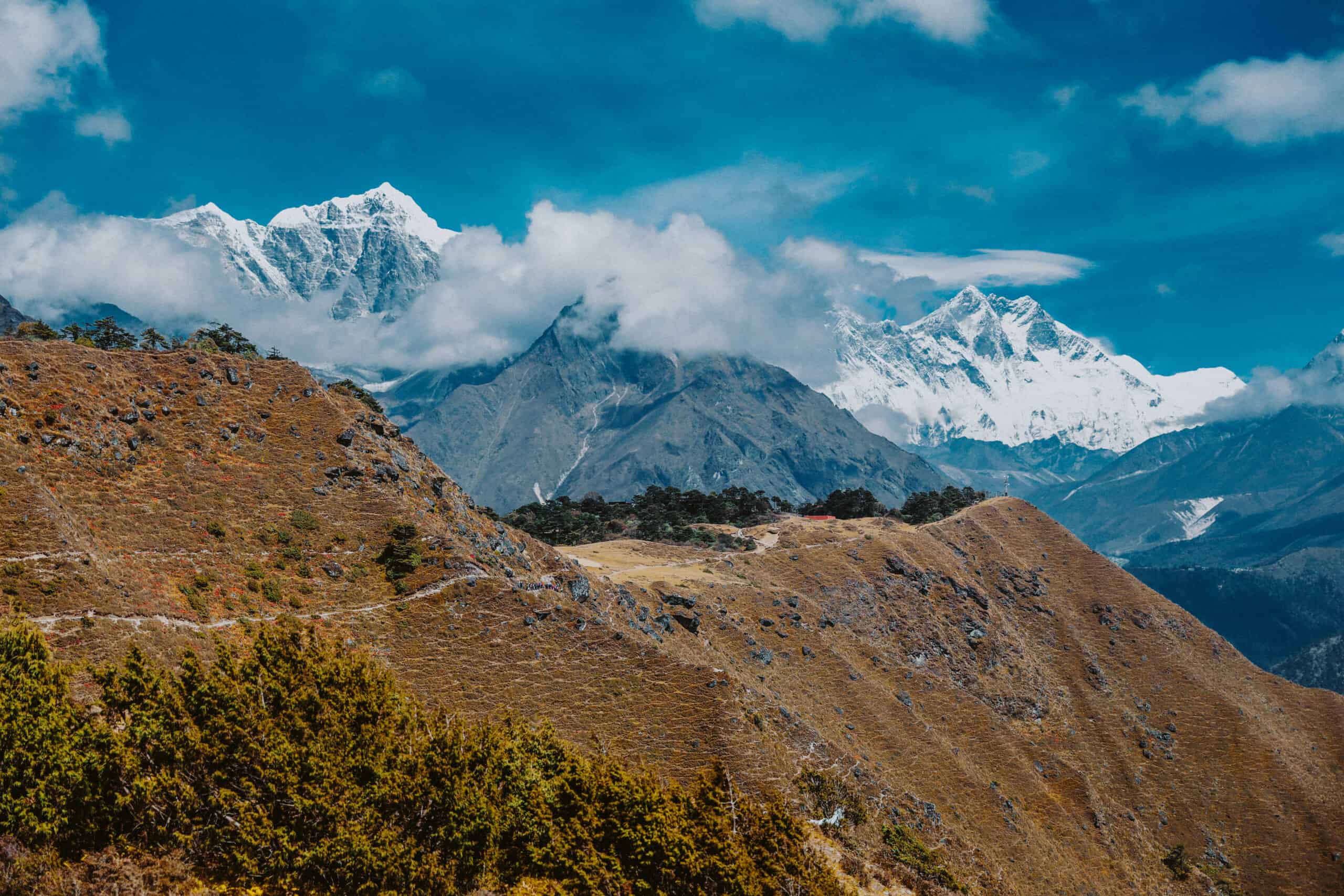
If you are planning to undertake the Everest Base Camp Trek in September, read through this post till the end. I am sure it will provide you with the information that you are looking for and help you make it the trip of a lifetime.
Autumn in Nepal starts in the month of September, which means that one can witness the clear blue sky, amazing vegetation and the least rain towards late September.
The friendly locals and cool, mild temperatures welcome a lot of trekkers and travelers to do the Everest Base Camp trek in September.
The Everest Base Camp trek is a dream trail for many trekkers and adventure seekers. It is an adventure of a lifetime and a journey that engraves itself into the heart of the explorer.
Far away from the fast-paced modern life of same routines and constant mobile use, this journey will quench the thirst of your soul and feed it with the best of nature.
Exploring the magnificent landscape and diversity of the place during the trek is an amazing experience.
The different groups of ethnic people, their culture and lifestyle, various high Himalayan mountains, flora, and fauna are what make this trek unique and memorable.
The Everest region offers you a close-up view of some of the most beautiful and highest mountains in the world, including Mount Everest standing at 8,848.86 meters.
September is one of the best times to trek along the trails of the Everest Region as it has a lot to offer you.
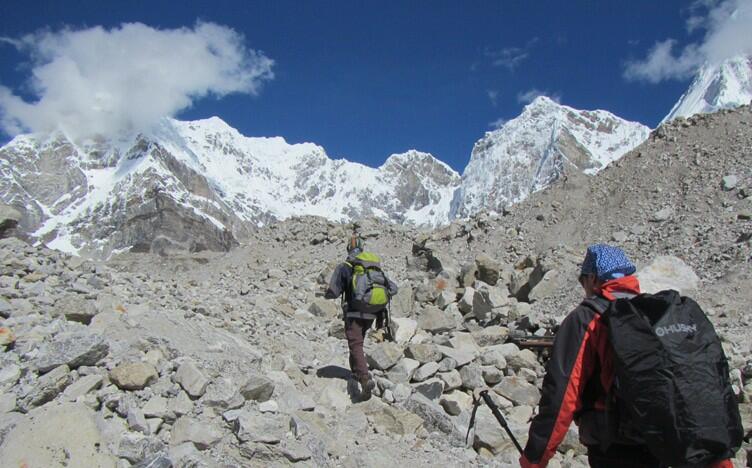
Table of Contents
Weather during the Everest Base Camp Trek in September
A good flight and scenic views, namche bazar, fewer crowds and better accommodations, amazing views, unique opportunity to learn about sherpa culture, itinerary for everest base camp trek in september, everest base camp – cho-la pass – gokyo trek in september, everest high passes challenging trek in september, jiri to ebc trek in september, check and re-check packing list, advance booking, be prepared for the unexpected flight delays, pack insect repellents, physical and mental preparation, altitude sickness, safety and emergency contacts, conclusion:.
Starting in September, autumn begins in Nepal, bringing with it very pleasant weather on the trail to Everest Base Camp .
This means that one should expect temperatures that are neither too hot nor too cold.
You may experience some light rainfall during the early days of September, but only until Tyangboche. Rain during the month of September is not very frequent, so the weather is generally warm and welcoming.
Nights and early mornings in the mountain regions are cold in September, but not as harsh as during the winter months.
The daytime temperature can vary from 18 degrees Celsius to 24 degrees Celsius at lower altitudes and gradually become colder as you climb up.
During the nights, temperatures can easily drop to minus 5 to minus degrees Celsius. However, temperatures depend entirely on altitude.
At higher altitudes (4500+ meters), the temperature may average 0 to 10°C during sunny days.
However, sometimes it can still drop to minus 10 to minus 15 °C during the nights at an altitude of 4500 meters above sea level.
The temperature may vary in the following ways:
Want more information? Send us your query, and our experts will get back to you within 24 hrs.
- Full Name *
- Address Select Country Afghanistan Albania Algeria American Samoa Andorra Angola Anguilla Antarctica Antigua and Barbuda Argentina Armenia Aruba Australia Austria Azerbaijan Bahamas Bahrain Bangladesh Barbados Belarus Belgium Belize Benin Bermuda Bhutan Bolivia Bonaire, Sint Eustatius and Saba Bosnia and Herzegovina Botswana Bouvet Island Brazil British Indian Ocean Territory Brunei Darussalam Bulgaria Burkina Faso Burundi Cabo Verde Cambodia Cameroon Canada Cayman Islands Central African Republic Chad Chile China Christmas Island Cocos Islands Colombia Comoros Congo Congo, Democratic Republic of the Cook Islands Costa Rica Croatia Cuba Curaçao Cyprus Czechia Côte d'Ivoire Denmark Djibouti Dominica Dominican Republic Ecuador Egypt El Salvador Equatorial Guinea Eritrea Estonia Eswatini Ethiopia Falkland Islands Faroe Islands Fiji Finland France French Guiana French Polynesia French Southern Territories Gabon Gambia Georgia Germany Ghana Gibraltar Greece Greenland Grenada Guadeloupe Guam Guatemala Guernsey Guinea Guinea-Bissau Guyana Haiti Heard Island and McDonald Islands Holy See Honduras Hong Kong Hungary Iceland India Indonesia Iran Iraq Ireland Isle of Man Israel Italy Jamaica Japan Jersey Jordan Kazakhstan Kenya Kiribati Korea, Democratic People's Republic of Korea, Republic of Kuwait Kyrgyzstan Lao People's Democratic Republic Latvia Lebanon Lesotho Liberia Libya Liechtenstein Lithuania Luxembourg Macao Madagascar Malawi Malaysia Maldives Mali Malta Marshall Islands Martinique Mauritania Mauritius Mayotte Mexico Micronesia Moldova Monaco Mongolia Montenegro Montserrat Morocco Mozambique Myanmar Namibia Nauru Nepal Netherlands New Caledonia New Zealand Nicaragua Niger Nigeria Niue Norfolk Island North Macedonia Northern Mariana Islands Norway Oman Pakistan Palau Palestine, State of Panama Papua New Guinea Paraguay Peru Philippines Pitcairn Poland Portugal Puerto Rico Qatar Romania Russian Federation Rwanda Réunion Saint Barthélemy Saint Helena, Ascension and Tristan da Cunha Saint Kitts and Nevis Saint Lucia Saint Martin Saint Pierre and Miquelon Saint Vincent and the Grenadines Samoa San Marino Sao Tome and Principe Saudi Arabia Senegal Serbia Seychelles Sierra Leone Singapore Sint Maarten Slovakia Slovenia Solomon Islands Somalia South Africa South Georgia and the South Sandwich Islands South Sudan Spain Sri Lanka Sudan Suriname Svalbard and Jan Mayen Sweden Switzerland Syria Arab Republic Taiwan Tajikistan Tanzania, the United Republic of Thailand Timor-Leste Togo Tokelau Tonga Trinidad and Tobago Tunisia Turkmenistan Turks and Caicos Islands Tuvalu Türkiye US Minor Outlying Islands Uganda Ukraine United Arab Emirates United Kingdom United States Uruguay Uzbekistan Vanuatu Venezuela Viet Nam Virgin Islands, British Virgin Islands, U.S. Wallis and Futuna Western Sahara Yemen Zambia Zimbabwe Åland Islands Country
- Trip Title *
- Number of Days
- Group Size *
- Travel Date Day Month Year
- Contact Number *
- Your Email *
- Describe Your Trip *
Perks of Everest Base Camp Trek in September
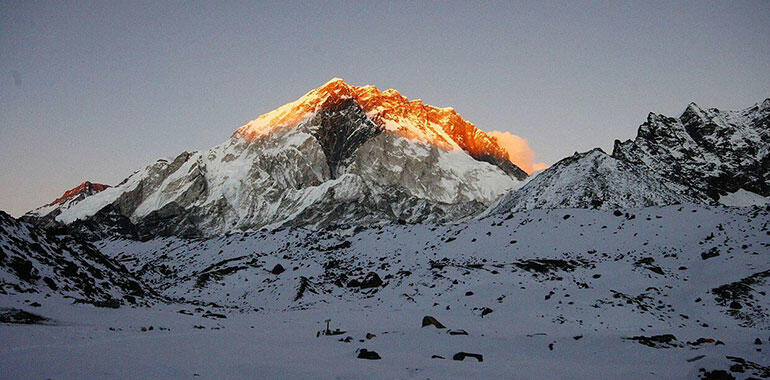
Trekking in Nepal is possible throughout the year, and the EBC is no different.
Hence, if you are planning the Everest Base Camp Trek in September, you can enjoy some of these amazing perks, including:
Since September has very clear and mild weather, you will have the chance to witness amazing views of the mountain ranges from your plane itself.
There are chances of flight delays and cancellations, but as crowds haven’t started yet, you can easily reschedule your ticket to Lukla for the next day.
The weather is crisp and stable, and you may not have to wait long for the flights to Lukla to start your amazing adventure to reach EBC.
Namche Bazaar, the capital city of Sherpas, is exciting to visit during September with fewer people enjoying the famous town other than yourself.
Also, the weather serves you with the best views.
The town has a stable climatic condition in late September, and the people have a wonderful welcoming nature.
It allows you to have a good outlet to stroll in the place and get accustomed to the wonder of the town.
Impeccable views of the pristine mountains during the rain-washed September surroundings are absolutely breathtaking.
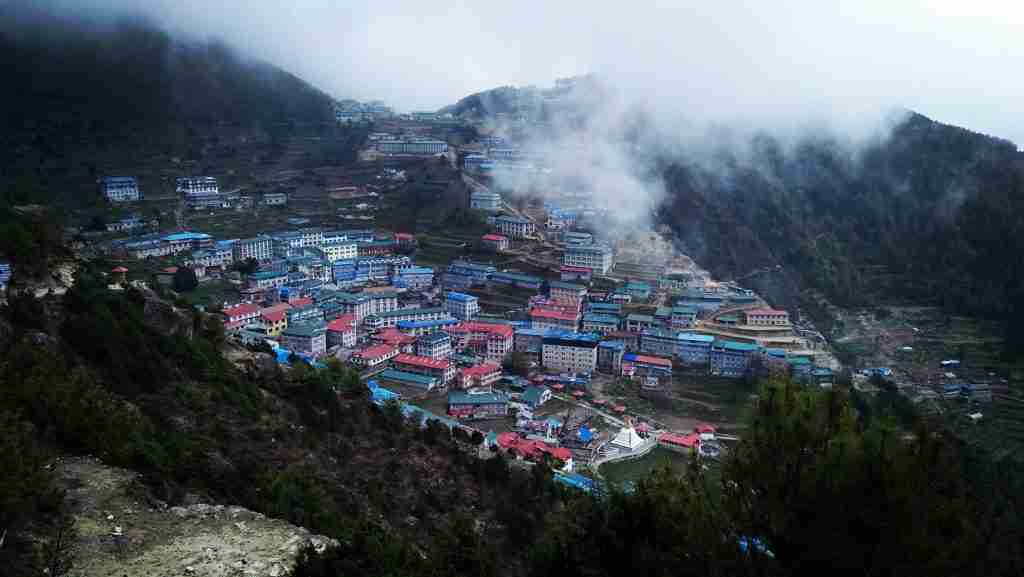
During this time of the year, you can feel that the entire route is “yours.”
With fewer crowds, you can have more time with nature in solitude.
Early September sees fewer trekkers, so you can get better accommodation options.
Also, you will have access to better options for food, rooms, and other services.
As there are fewer people, they will treat you better compared to peak season.
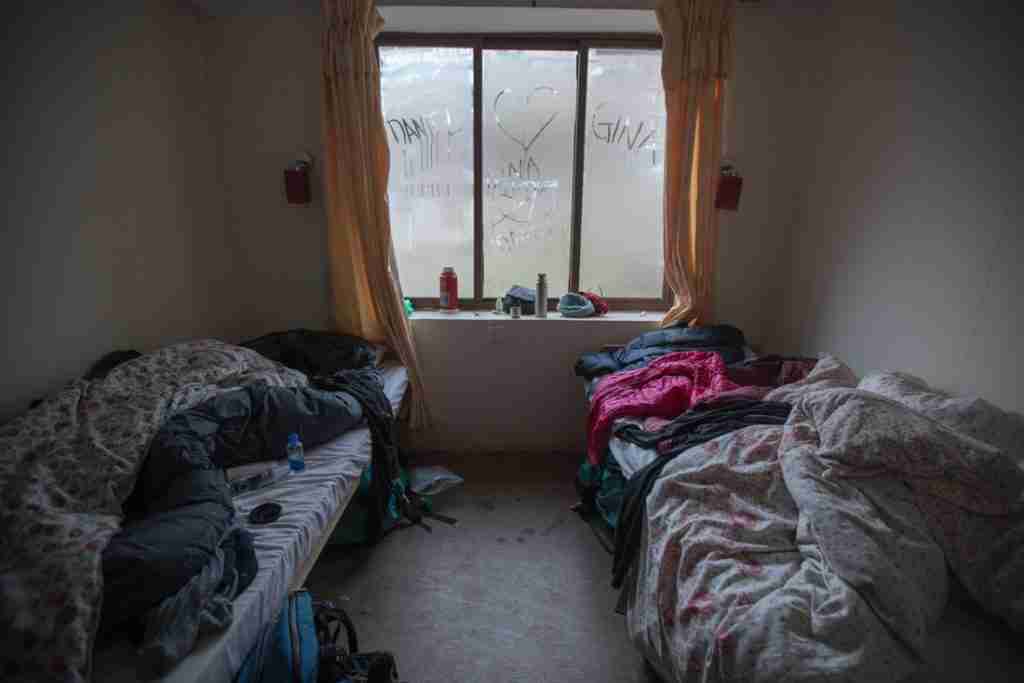
The snow-capped mountains are definitely the most significant view one expects to see while trekking the EBC trail.
If you’re trekking at the beginning of September, the Everest trail will bless you with lush green hills, waterfalls, and rice fields.
September marks the beginning of autumn, so you can enjoy the blooming flowers and greenery with crystal clear weather.

September is famous not only as the trekking season but also as the month that officially starts the festival season.
You will get acquainted with festivals like Indra Jatra ,
Dashain, Teej, etc., while you are in Kathmandu. Keep some extra days after the trek to participate in these festivals with the locals.
Everest Base Camp trek in September is a special chance to learn about Sherpa people and their culture.
As you trek through the Himalayas, you’ll see colorful monasteries, prayer flags and chortens, which are part of their Buddhist beliefs.
Talking with the Sherpa people, who are famous for climbing mountains, helps you understand their traditions, friendly nature and how they live.
During low season of September, Sherpas have more time to talk to trekkers, so you can learn from them and share experiences.
You might also see Sherpa festivals, try their tasty food in teahouses and buy their beautiful crafts to support their community.
This cultural experience makes your trek even more special and meaningful.
Day 1 : Arrival in Kathmandu (1345m/4412ft), meet at the airport, and transfer to the hotel. Pre-trek meeting in the evening.
Day 2 : Pick up from the hotel in Kathmandu and drive to the airport to board a short flight to Lukla (2840m/9320ft). From Lukla, trek to Phakding (2610m/8560ft) – approximately 3.5 hours. Temperature: around 20°C (68°F).
Day 3 : Trek to Namche Bazaar (3440m/11290ft) – Approximately 6 hours. Temperature: around 15°C (59°F).
Day 4 : Acclimatization day trip around Namche Bazaar. Side trip to a higher altitude and return to Namche. Temperature: around 12°C (54°F).
Day 5 : Trek to Tengboche, also known as Tyangboche (3860m/12660ft) – Approximately five hours. Temperature: around 10°C (50°F).
Day 6 : Trek to Dingboche (4360m/14300ft) – Approximately 5 hours. Temperature: around 8°C (46°F).
Day 7 : Another acclimatization day. Temperature: around 8°C (46°F).
Day 8 : Trek to Lobuche (4940m/16207ft) – Approximately 5 hours. Temperature: around 6°C (43°F).
Day 9 : Trek to Everest Base Camp (5300m/17400ft) and return to Gorak Shep (5170m/16961ft). Temperature: around 4°C (39°F).
Day 10 : Sunrise viewing hike up to Kalapatthar (5545m/18192ft) then trek to Pheriche (4270m/14070ft) – Approximately 7 hours. Temperature: around 4°C (39°F).
Day 11 : Return trek to Namche Bazaar (3440m/11290ft) – Approximately 6 hours. Temperature: around 10°C (50°F).
Day 12 : Namche Bazaar to Lukla (2840m/9320ft) – Approximately 6 hours. Temperature: around 15°C (59°F).
Day 13 : Fly back and transfer to the hotel in Kathmandu. Temperature: around 25°C (77°F).
Day 14 : Departure or extend your tour for other activities in Nepal.
- Please note that the temperatures mentioned are approximate (daytime temperatures) and can vary based on weather conditions along with the time of day in September.
- At night, temperatures can drop below minus 15 degrees Celsius or 5 degrees Fahrenheit.
- It’s always a good idea to check the weather forecast before embarking on the trek.
- Above 14-day itinerary is the standard trip itinerary we offer.
- We run this tour throughout the year, including September. Please browse our Everest Base Camp Trek page for more information and available dates.
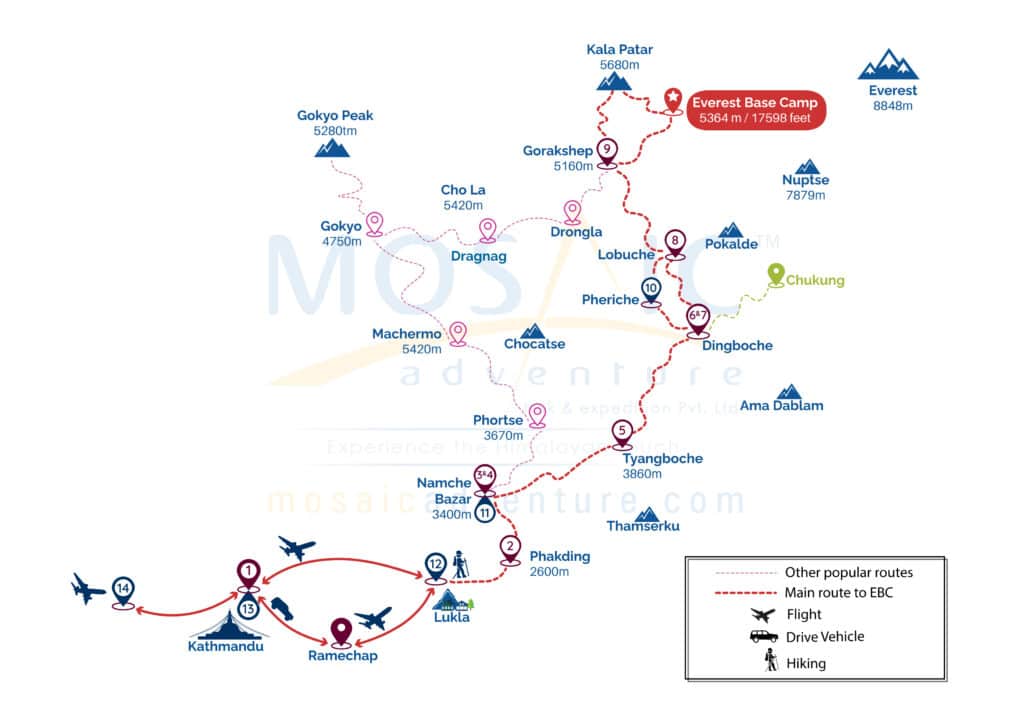
Alternative Routes for Everest Base Camp Trek in September
If you are looking to explore the EBC trek, there are a couple of alternate options along with the classic trail that reaches the base camp.
You can enjoy the route at your own pace as the cool and stable September weather accompanies you throughout.
Some other popular routes to the Everest Base Camp are:
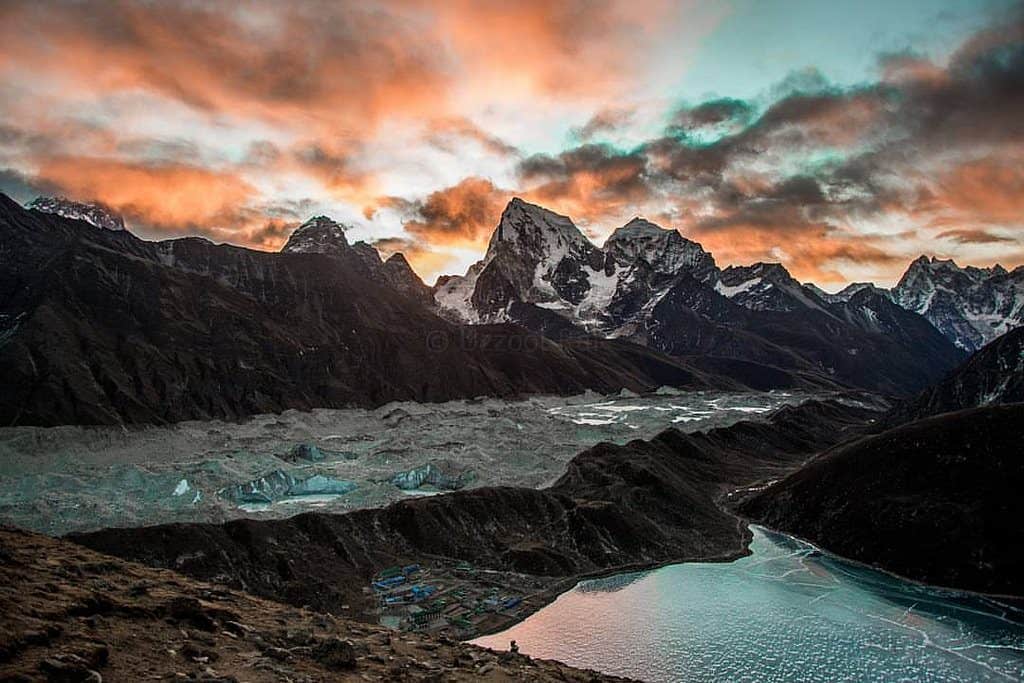
One of the most adventurous treks in the Everest Range is the Gokyo Lakes Trek via Cho La Pass . It follows the Base Camp route, passing through the buzzing town of Namche Bazar.
You will be trekking to three different points in this trek: the Everest Base Camp at 5380m, the Cho-La Pass at 5420m, and the Gokyo valley at 4750m.
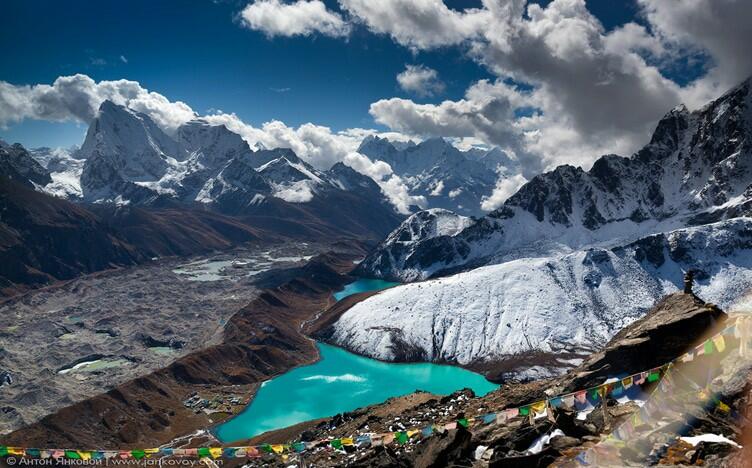
All three popular visiting destinations are challenging and adventurous. Trekking to these points requires immense physical fitness and mental strength.
You can also witness the amazing Tyangboche monastery on this trip.
This magnificent monastery lies amidst the panoramic view of the mountain range.
You will also get to hike the infamous Kala Pathar, at 5545 meters, which is the highest point of this trek.
Highlights of the Trek
- Namche Bazar: The highest trade center, and the gateway to Everest.
- Tengboche Monastery – the oldest monastery in the region
- Close view of some of the world’s highest mountain peaks. Some are Mount Cho Oyu (8201m), Mount Makalu (8463 m), Mount Lhotse (8516 m) and Mount Everest (8848 m) and other mountain ranges of 7000m.
- Nepal’s largest glacier, Ngozumpa Glacier
- Gokyo Ri (5357 m). It is the best point to see the Gokyo valley, surrounding lakes and glaciers.
- The highest pass of the trek- Cho La Pass.
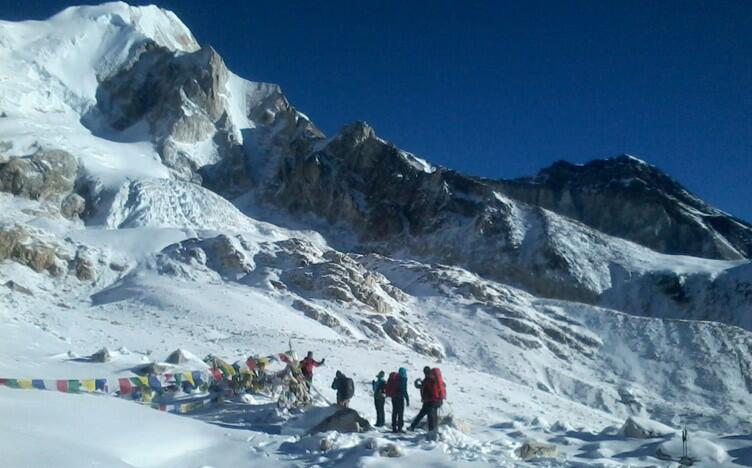
The Everest Three Pass Trek is a highly challenging yet adventurous route in the Everest Region.
It covers most of the parts of the Everest Region, and you venture into the Khumbu region through the Everest Base Camp and Kala Pathar.
You will pass through three mountain passes, which are challenging and serene.
You will reach Lobuche via the Kongmala Pass, Thangnak via the Chola-la Pass, and Lungdhen via the Renjola Pass.
September is the best time of the year for this trek.
The thrill and challenge you face during this trek are best supported by the September weather.
Highlights of the trek are:
- The three passes – Renjola Pass (5435m), Chola pass (5420m) and Kongma La Pass (5535m)
- Everest Base Camp, Kala Pathar and Gokyo Lake
- Climbing to Gokyo Ri (5375 meters)
- Tengboche Monastery
- Amazing views of the glaciers and Khumbu Icefall
- The flora and fauna inside the Sagarmatha National Park
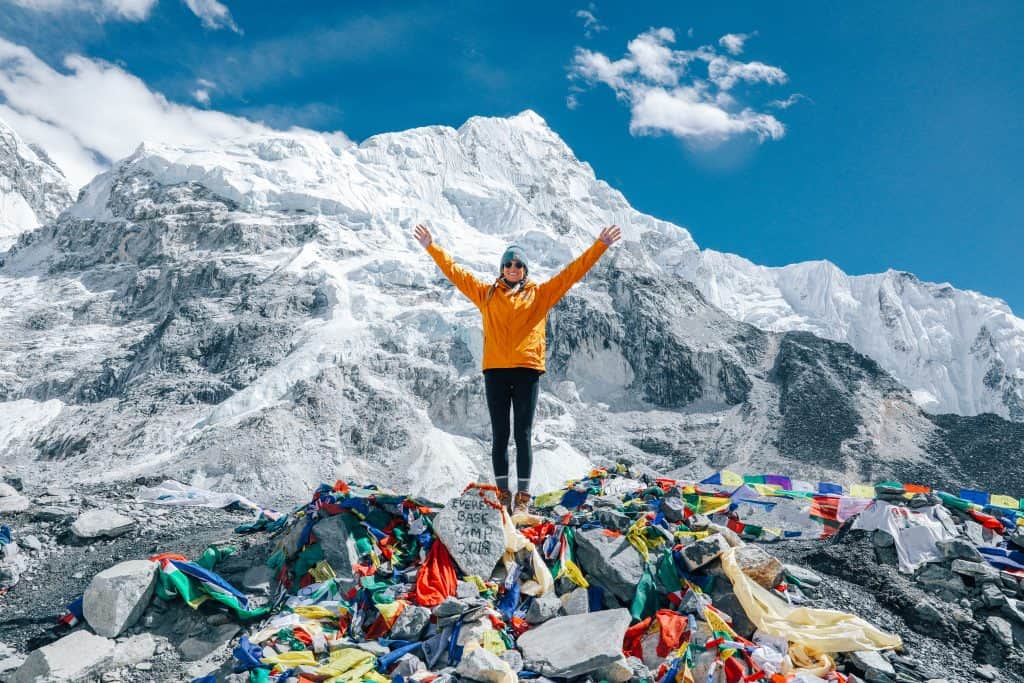
The classic Jiri to EBC Trek is a route with a twist. It starts from the lower altitudes of Jiri, unlike the trek that starts directly from a high altitude in Lukla.
It is called a classic route as it is the original route to the Base Camp of Mt Everest before the Lukla airport was built.
Sir Edmund Hillary and Tenzing Norgay Sherpa walked through this route in the 1950s.
As this trek starts from a lower altitude and gradually increases as you trek, the trekkers acclimatize better as there is more time for it.
The trek eventually joins the more popular Lukla route and continues towards Namche Bazar.
Highlights of the Trek:
- Trekkers can witness the amazing combination of natural and cultural beauty.
- Witnessing the amazing beauty of Mt. Lhotse, Mt. Nuptse, Mt. Pumori, and Mt. Thamserku.
- It is a trek into the heart of Sherpa culture and tradition. You can experience the unique cultural performances and festivals in the monastery.
- Exploring the landscape, flora, and fauna of the Khumbu region along with the amazing views of the lush valley surround by the Himalayas.
- The Kala Pathar Hike and Tengboche Monastery
Tips for Everest Base Camp Trek in September

The weather and temperature vary according to the altitudes.
Early September may experience monsoon rain, so you need to pack rain gear, water-proof backpacks for the trek, along with all essential items.
Read through this post if you are looking for the ultimate packing list for the Everest Base Camp Trek .
Towards late September, the Everest region experiences autumn weather, so the days are hot with colder nights.
As a trekker, layering is key. You need to choose clothing that wicks sweat and moisture, keeping you fresh and comfortable.
Be sure to wear a good pair of waterproof trekking boots and waterproof socks.
Well, a pair of convertible trekking pants does not hurt.
For the Everest Base Camp Trek in September, you must be very careful about the packing because you may face frequent weather changes on some unfortunate days.
Pre-booking always helps. You may not have to do so in early September, but it’s better to be safe than sorry.
Tourist flow increases by mid-September. This increase in the number of trekkers increases crowds in the teahouses . So, you may have difficulty finding the best place for food and accommodation.
So, it is a better idea to pre-book food and accommodation if you are planning the Everest Base Camp trek in September.
If you have booked the trek with a tour operator in Kathmandu, they will arrange these logistics so you don’t have to worry about them at all.
As September is the transition month between the monsoon and autumn season, you may sometimes face unexpected weather changes.
The dense cloud and heavy shower may sometimes lead to cancellations or delays of the Lukla flight.
So, as you go for this trek in September, like doing it in any other month, it is good to spend a few extra days for some unpredictables that may occur on the trek or while taking a flight to/from Lukla.
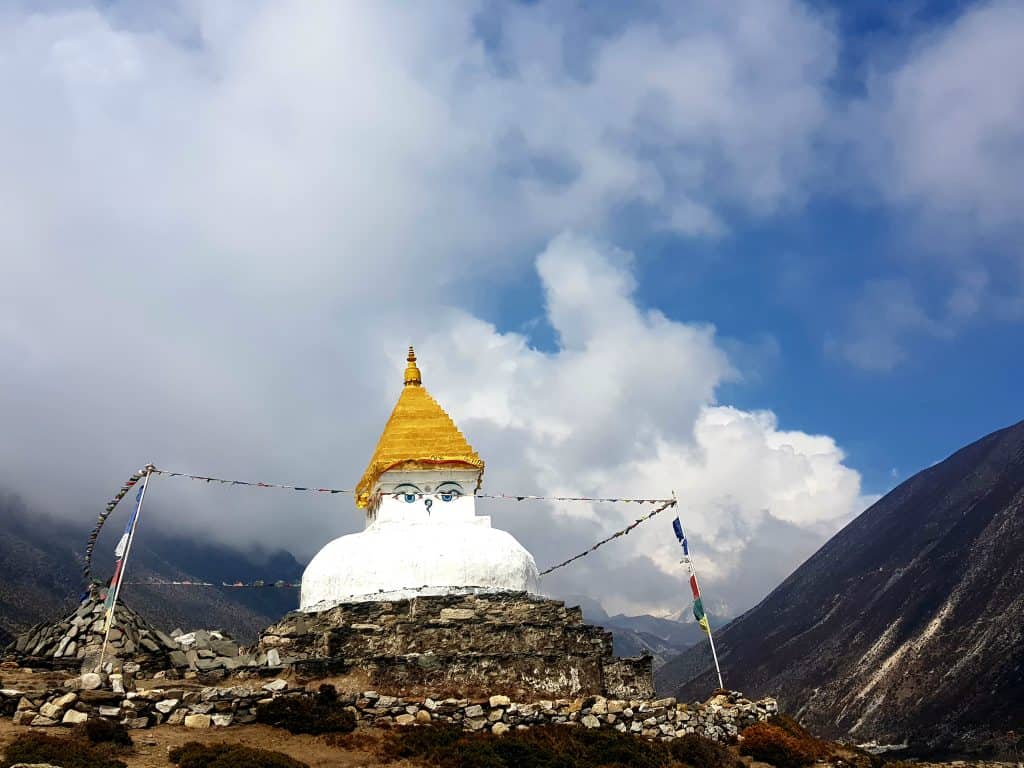
The Everest Base Camp Trek in September means you will witness the traces of Monsoon in the trekking trails.
You may encounter some bugs, especially in the lower altitudes of the trek. So, to avoid any inconvenience caused by them, you can carry insect repellents.
Getting ready for the Everest Base Camp trek in September is important for a successful and enjoyable journey.
Here are some tips to prepare yourself physically and mentally:
- Fitness Training: Improve your stamina by regularly hiking, running, or cycling. Strengthen your legs and core muscles to handle the challenging terrain.
- Endurance Building: Practice hiking with a backpack to get used to trekking conditions. Gradually increase the distance and how high you go.
- Mental Readiness: Be mentally prepared for the demands and challenges of the trek. Stay positive and determined throughout the journey.
- Training at Altitude: Spend a few days at higher altitudes (like Nagarkot which is 2175 meters / 7135 feet) before starting the trek. This helps your body adjust better to the higher elevations.
- Hydration and Nutrition: Keep yourself hydrated and eat a balanced diet with carbohydrates and proteins to keep your energy levels up.
Altitude sickness can be serious during the trek. Here’s what you should know:
- Symptoms: Headache, dizziness, nausea, fatigue, and difficulty breathing.
- Prevention: Go slowly, acclimatize well, drink enough water, avoid drinking alcohol and smoking, and ascend gradually.
- Treatment: Rest and go down if you have mild symptoms. Get immediate medical help for severe cases.
- Medication: Carry altitude sickness medicine, but consult with your doctor first.
Safety is important during the trek. Remember these things:
- Tour operator / Trekking Agency: Choose a reputable local agency with experienced guides.
- Weather Awareness: Be ready for sudden weather changes.
- Altitude Monitoring: Tell your guide if you feel uncomfortable.
- Medical Facilities: Basic help is available, bring a first-aid kit.
- Emergency Contacts: Save important numbers, including rescue services.
Everest Base Camp Trek in September can be a memorable experience. The soothing and pleasant temperature, clear view of the flora and fauna, and the breathtaking mountain ranges add to your trekking memories.
You will have easy options for food and accommodations, peaceful hikes, and cheaper options for flights and hotels.
I hope that by reading the information above, you now have a better idea about the trek. Your Everest Base Camp trek in September will be safe and rewarding.
Remember to take care of yourself and your fellow trekkers during this amazing journey.
Enjoy your Himalayan adventure in September!
For further questions and queries regarding the trek or other trekking options, feel free to contact us .
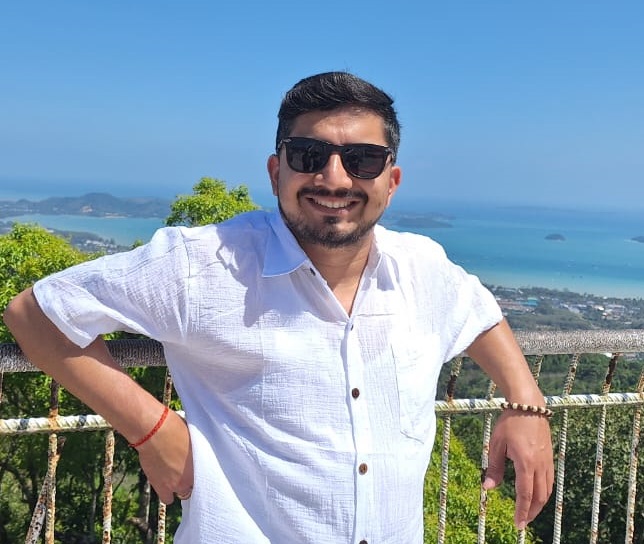
Madhav started working as a porter in 2001 and then moved on to work as a trekking guide. After working in the trekking and tourism industry for eight years, he co-founded Mosaic Adventure in 2009.
Madhav has trekked to most of the trekking destinations in Nepal, including Everest Base Camp Trek, Annapurna Base Camp, Annapurna Circuit Trek, Poon Hill Trek, Jomsom Muktinath Trek, Indigenous Peoples Trek, Langtang Valley Trek, Mardi Himal Trek, and all of the day hikes around Kathmandu.
He has also extensively traveled to other countries such as Australia, the USA, the UK, France, Hong Kong, Japan, China, the Philippines, the UAE, Saudi Arabia, Bahrain, Thailand, Turkey, and India. Madhav is the one who answers most of your questions about trekking and tours and helps to plan your trip by giving a personal touch.
You may also be interested in...
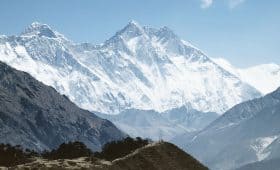
How to Prevent Altitude Sickness on Everest Base Camp Trek
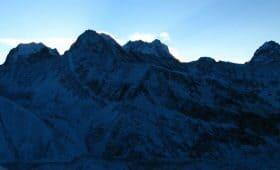
Everest Gokyo Trek Itinerary
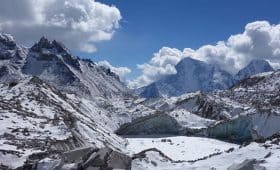
Everest Base Camp Weather
Leave a reply cancel reply.
Your email address will not be published. Required fields are marked *
Save my name, email, and website in this browser for the next time I comment.
Check Our Risk-Free Booking Policy View Details
No recent searches!
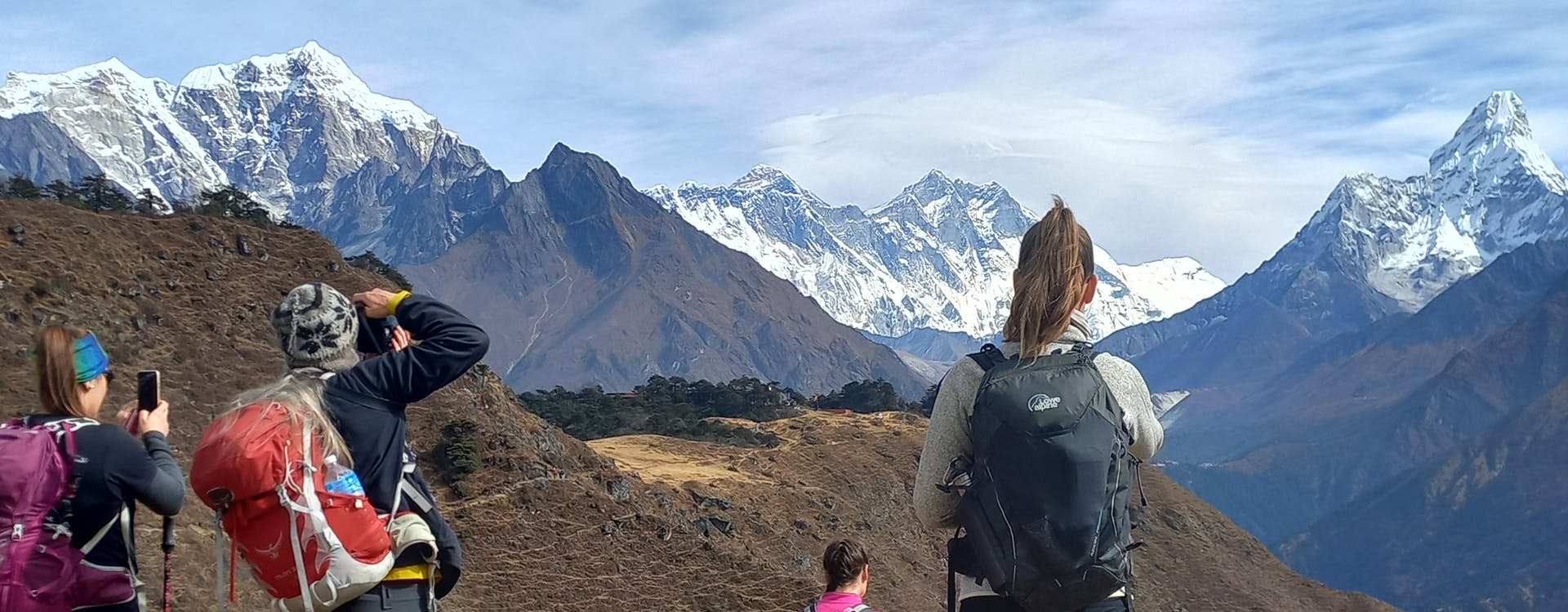
- Everest Base Camp Trek in September

September rings in the autumn season, the most popular trekking season in Nepal. Everest Base Camp Trek in September promises pleasant weather and crystal-clear views of the mountains. It is also the time when locals celebrate some important festivals. After months of inactivity, the trail is abuzz with trekkers, and local shops and teahouses start doing good business again. If you are planning an Everest base Camp Trek in September, here are some pros and cons that you should consider.
Most Popular Trips to Everest Base Camp 2023/024
Pros of trekking to EBC in September
- The weather gets pleasant with the end of the rainy season. But be prepared for some precipitation or rainfall in the first half of September.
- The sky remains cloudless for the most part of the day which means you can enjoy clear views of the mountains
- All the lodges and teahouses remain open
- Opportunity to meet trekkers from different parts of the world
- Fewer chances of flight cancellation due to bad weather
- Lukla flights operate from Kathmandu airport
Weather in September
September brings in balmy weather and clear skies, which makes trekking in the mountains a pleasant experience. It's neither too hot nor too cold in September. However, sometimes the monsoon season may linger for a while and it's usual to receive a bit of rainfall in the first half of September. So be prepared and carry your rain gear.
The average temperatures recorded in Lukla during the month of September are a maximum of 21°C and a minimum of 10°C. In Namche, the maximum average temperature is 17°C and the minimum is 6°C.
At Gorak Shep, the highest overnight stop at 5164 meters, the maximum temperature will be 8°C and the minimum -2°C.
Accommodation
All the teahouses and lodges in the Everest Region open up for business by September. It will be easier to get accommodation at all the stops en route as all the local business owners return to the Khumbu Region at the start of the tourist)season. Unlike in summer or monsoon season and winter, all the teahouses receive guests.
Irrespective of the season you plan your trek, an Everest Base Camp Trek should be regarded as a risky high-altitude trekking adventure. The elevation gains while trekking will make you breathless and if not properly acclimatized, symptoms of AMS (acute mountain sickness) is sure hit you.
The symptoms of altitude sickness should be taken seriously. If one suffers from AMS, steps should be taken to relieve the symptoms immediately by sleeping at a lower altitude and taking Diamox. If the symptoms worsen, then the person should be evacuated by helicopter to a medical facility in Kathmandu. The symptoms if ignored, can turn fatal. There have been instances of trekkers losing their lives after they decided to push on in spite of suffering from AMS.
Proper acclimatization is very important to ward off AMS. To let your body acclimatize properly, you need to spend at least two days acclimatizing. The lack of oxygen will make your body feel uncomfortable and tired. Breathlessness, headache, nausea, and dry cough are some of the common ailments trekkers suffer from as they walk closer to EBC. Try to keep yourself warm and hydrated by drinking lots of ginger tea, garlic soup, and warm water.
While buying your travel insurance, make sure that it covers accidents, illnesses, and rescue and evacuation above 5000 meters.
What to pack?
- A large duffel bag or rucksack to carry your clothes and other items and a small daypack to carry your camera, cash, and important documents. Both should have rainproof covers.
- Sturdy hiking boots with excellent grip
- Trekking poles
- Rain gear (raincoat or umbrella)
Clothing: Enough change of clothes to last you throughout your trek. Carry clothes that are light and sweat-absorbent. While the days are warm, the nights can be chilly with temperatures dipping below zero. Beyond Namche, it will get cold and icy, especially during the night. Therefore carry enough warm clothes (down jacket, warm hat, gloves, base layers, buff, trekking pants with insulation, etc.).
Accessories and Toiletries: Must-haves are goggles with UV shield, sunscreen lotion, moisturizer, towel(lodges do not provide towels), shampoo, soap, toilet paper roll, hand sanitizer, wet wipes, lip balm, etc.
A power bank to charge your phone and other devices is a must. If you want to record your journey, carry extra batteries for your camera. Another essential item is a head torch.
Do not forget to carry Diamox, paracetamol, diarrhea medicine, throat lozenges, band-aid strips, pain relieving balm and other prescribed medicines with you.
Since card payment is not accepted at most of the teahouses and shops en route, you should carry enough local currency. Remember food items cost more in the mountains than in the cities.

Alternate Routes
The trek to Gokyo Lakes can be an enriching experience. The Gokyo Lakes are the world's largest freshwater lake system in the world. Surrounded by glaciers and jagged peaks, Gokyo is worth a visit when you are in the Everest Region.
You can cross the 3 High Passes in the Himalayas – Cho La, Renjo La, and Kongma La. These are challenging mountain passes, and crossing them seems like a mini mountaineering expedition.
You can also take a detour to Ama Dablam Base Camp and savor views of the majestic Ama Dablam, the most beautiful mountain in Khumbu.
Trekking to Everest Base Camp via the rarely explored Hinku and Hongku Valley and the Makalu Barun National Park can be a thrilling adventure. This route, generally used by Mera Peak expedition groups, is filled with amazing glaciers, ice lakes, and a challenging crossing of a high mountain pass known as the Amphu Labtsa Pass.
If you are pressed for time you can take a heli tour to Everest Base Camp . It takes less than half a day to fly to Everest Base Camp, explore the viewpoint of Kala Patthar, and return to Kathmandu.
You can also shorten your trek to EBC by booking a heli trek. You can either fly to Namche via helicopter and begin your trek from there or take the regular trail to Everest Base Camp from Lukla and return via helicopter.
Indra Jatra one of the biggest street festivals in Kathmandu valley is celebrated in September. The festival, which lasts for eight days, is an important festival for Newars living in Kathmandu. During the eight days, people throng to the Basantapur Durbar Square to worship deities, watch masked dances, and take part in the boisterous chariot-pulling festival where the wooden chariots of Kumari, the Living Goddess, and other Hindu deities are pulled by devotees to different Newari toles (localities). Lakheys or masked dancers accompanied by traditional musicians perform in the street.
The festival also honors Indra, the lord of heaven, and Bhairav, a manifestation of Lord Shiva. Huge masks of Bhairav which are otherwise kept hidden throughout the year, are displayed during Indra Jatra. The masks of Akash Bhairav and Swet Bhairav attract a lot of devotees. The mask of Swet Bhairav which is displayed in front Hanuman Dhoka Palace attracts a lot of young men as on some days local liquor is dispensed from its mouth.
Sometimes Dashain the biggest festival of the Hindus is also celebrated in September. Since Hindu and Buddhist festivals are observed according to the lunar calendar, the dates vary each year.
September is the start of the busy autumn season. However, the trail will be less crowded if you plan your Everest Base Camp Trek in the first few weeks of the month. Though warm and pleasant, you can expect some rainfall and thundershowers in September.
Trekking to Everest Base Camp in September gives you some of the best views of the mountains from the trail. The trail is filled with people and villagers who have migrated to the lower towns and cities and returned to their mountain homes. The atmosphere on the trail is livelier and cheerful, and it's a joy to walk in the crisp mountain air.
- Everest Base Camp Trek
- Acclimatization & Safety protocols on EBC trek
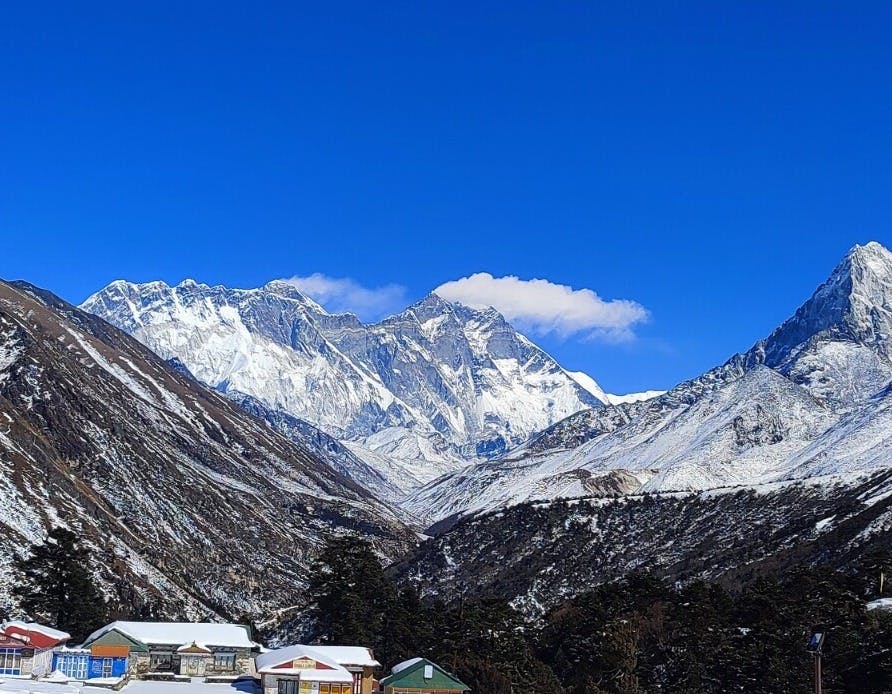
Post a Comment
Subscribe our e-newsletter.
Sign up for Deals and Discount. Get News, Notifications and Updates about the recent Events and Offers.
Main Navigation
Annapurna region.
- Mardi Himal Trek
- Annapurna Base Camp Trek
- Annapurna Circuit Trek
- Annapurna Panorama Trek
- Poon Hill Sunrise Trek
- Annapurna Sanctuary Trek
- Nar Phu Valley Trek
- Poon Hill Trek
- Annapurna Sunrise Trek
- Ghorepani Poon Hill Trek
- Ghorepani Ghandruk Loop Trek
- 4 Days Poon Hill Trek
- Annapurna Short Trek
- Poon Hill Annapurna Base Camp Trek
- Poon Hill Trekking package
- Short Mardi Himal Trek
- 5 days Annapurna Base Camp Trek
- 6 Days Annapurna Base Camp Trek
- 10 Days Poon Hill Annapurna Base Camp Trek
Everest Region Trek
- EBC Helicopter Tour with Landing - 1 Day
- Luxury EBC Trek with Helicopter Return - 5 Days
- EBC Trek with Helicopter Return - 10 Days
- Short Everest Base Camp Trek - 11 Days
- Short Classic Everest Base Camp Trek - 12 Days
- Classic Everest Base Camp Trek - 14 Days
- Everest Base Camp Luxury Trek - 14 Days
- Gokyo Lakes Trek -14 Days
- Short Comfort EBC Trek -13 Days
- Comfort Everest Base Camp Trek - 15 Days
- Gokyo Renjo La Pass Trek - 15 Days
- Gokyo Cho La Pass EBC Trek - 18 Days
- Everest Three High Pass Trek - 19 days
Manaslu Region Trek
- Short Manaslu Circuit Trek
- Tsum Valley Trekking
- Rupina La Manaslu Circuit Trek
- Manaslu Tsum Valley Trek
- Manaslu Trek
Langtang Region Trek
- Langtang Helambu Trek
- Tamang Heritage Trek
- Langtang Easy Trek
- Langtang Trekking
- Langtang Ganja La Pass Trek
- Langtang Gosainkunda Circuit Trek
- Gosainkunda Helambu Trek
Dolpo Region Trek
- Beni - Lower Dolpo Trek
- Upper Dolpo Trek
- Lower Dolpo Trek
Eastern Region
- Complete Everest Base Camp Trek Package
- Rolwaling Trek
- Makalu Base Camp Trekking
Newly Open Trekking
Kanchenjunga region trekking.
- Kanchenjunga Base Camp Trek
- Kanchenjunga Circuit Trek
- Everest Base Camp Helicopter Flight Tour with Landing
- Kathmandu - Pokhara Tour
- Nepal Overland Tour
- Nepal Trekking Tour
- Nepal Trekking with Jungle Safari Tour
- Nepal Cultural Tour
- Nepal Tour with Kids
- Kathmandu-Pokhara-Chitwan-Nagarkot Hiking Tour
Peak Climbing
- Island Peak Climbing
- Mera Peak Climbing
- Lobuche Peak Climbing
- Yala Peak Climbing
- Chulu West Peak Climbing
- Naya Kanga Peak Climbing
- Pisang Peak Climbing
- Shivapuri Nagarkot Trek
- Nagarkot Dhulikhel Namobuddha Trek
- Pokhara Sarangkot Trek
- Hiking and Meditation trip in Nepal
- Annapurna Skyline Trek
- Kathmandu City Sightseeing Tour
- Namo Buddha Day Hiking Tour
- Bhaktapur Half Day Tour
- Nagarkot Sunrise Day Tour
- Nagarkot Sunset Day Tour
- Nagarkot Day Hiking Tour
- Chandragiri Hill Half Day Tour .
- Boudha-Pashupati-Bhaktapur Full Day Tour
- Bhutan Spiritual Tour
- Bhutan Cultural Tour
- Bhutan Short Spiritual Tour
- Tibet Overland Tour
- Kailash Manasarovar Yatra
- Tibet Shangrila Tour
- Tibet Special Tour
- Tibet Introductory Tour
- Lhasa Everest Base Camp Tour
- Simikot Kailash Lhasa Tour
- Simikot Kailash Zhangmu Tour
- +9779851082484

Everest base camp trek in September: Weather | Accommodation | Culture | Tips and Highlight
Everest base camp trek in september.
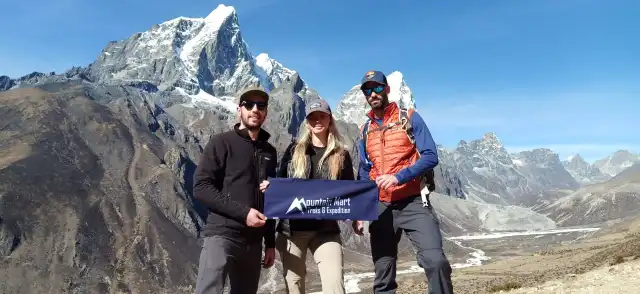
Table of Contents
Awesome weather.
September is the transition of two seasons ie. Summer and Autumn. In this month weather becomes so pleasant that means neither hot nor cold which makes your Everest base camp trek more memorable. You may experience a light rainfall in the early days of September but after the weather becomes clear that gives a fabulous view of the mountains and surroundings. In this month the trails get crowded because this is the best season for trekking into the Everest Region . You can experience a clear view of cosmic mountains, wildlife animals like blue sheep, deer, rare flora and fauna, and a green environment everywhere. This season is best for the photographers as well because all the views are so extensive and breathtaking. Everest base camp temperature in September is very delightful; in the daytime, it comes to be very warm and sunny while in the morning and night time it becomes cold. Do not worry MMT provides you a warm sleeping bag and blanket, as well as a fire chimney at the dining hall. Everest base camp trek temperature in September is as follows:
Remarks: Above data is for general information based on the last 5 years temperature recorded in the Everest Base Camp trekking trail during September.
Cultural Exploration
Everest Region is the overall repository of ancient, Buddhist culture and religion. While trekking to Everest base camp you may be able to closely watch and experience ancient architecture, sculpture, customs, and livings of Buddist Religions. You can see dozens of stupas and gompas in the trails. In Namche, you can talk with the local people about their customs and cultures and you can get more information about it. MMT expert guide helps you to grab more information about the culture and costumes for you in the Everest Trails .
Gigantic views of Mountains
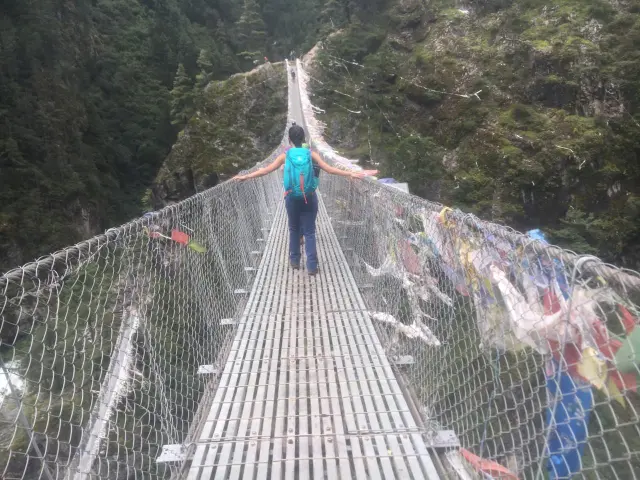
A Scenic Flight from Kathmandu to Lukla
In the off trekking season, there are high chances that your flight from Kathmandu to Lukla and return might get delayed and canceled. In the winter season, it may be delayed due to bad weather (ie. fog) while in the summer the rain is the main reason. But in the Autumn it is the high season for Everest Base Camp Trek and favorable weather for the Lukla flight. There are low chances of flight delays and cancellation of Lukla and return, so you can enjoy the beautiful scenery of the mountains.
Greater Accommodation and Food
September is the transition period of the two seasons; so, in this month the Everest Trails becomes quiet in comparison with the peak time. Less crowd in the trails provides you with the best accommodation in the tea house and lodges. You are able to choose the room you like the most. In the Everest region, you can choose a variety of food like western, continental, and local Nepali food (Daal, Vaat, Tarkari). MMT provides the three-time meals for the trekkers (like you); trekkers can choose the food of their choice. MMT health experts suggest you to drink at least 3 to 4 liters of water per day. This prevents you from dehydration as well as from the Altitude Sickness . MMT provides chlorine-treated water in the Everest Trek . 6. Three Pass Trek Everest Trek provides different shorter to longer trekking trails that are fit for all kinds of trekkers like a novice to professional. These trails are suitable for the trekkers who have shorter to longer vacations. Long treks like Everest Cho La Pass ( 5,420m/17,781ft) Trek 18 days , Everest Three Pass Trek 19 days (Kongma La (5,535m/18,158ft), Cho La Pass (5,420m/17,781ft) and Renjo La (5,345m/17535ft)) and Gokyo Renjo La Pass (5,360m/17584ft) Trek 15 days are doable and suitable for the month of September.
- Spectacular flight from Kathmandu to Lukla and return
- Cultural Exploration of Sherpa at Namche Bazar
- Tengboche monastery : an old monastery of the Everest Region
- Swinging and Suspension bridge at the EBC trek
- Rare flora and fauna at Sagarmatha National Park
- Khumbu Glacier, the largest glacier in Nepal
- Cho-La Pass (5420 m) , the highest pass of the trek
- Possibility of spotting wild animals at an alpine forest
- Glorious views of the Mt. Everest from the Kala Patthar
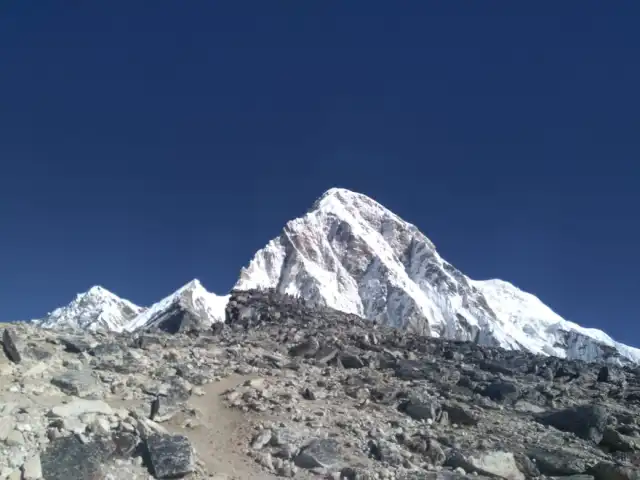
Carry insect repellent and table salt
In the early days of September, there are frequent chances of rainfall in the Everest route . Due to rainfall, you may find leeches, mosquitos, and bugs in the forest area. MMT experts suggest you to carry handy insect repellent or table salt to escape from these leeches and bugs.
Carry a waterproof jacket and bags
The weather in the mountains is unpredictable, so you need to prepare for this condition in advance. In the early days of September, there are high chances of rainfall in the upper part of the country. To secure from being wet you need to carry a waterproof jacket and bags.
- Advanced Booking
Advance booking always provides you with the best for your Everest Trekking . September is the beginning of the peak season for Everest base camp trek where the trails start getting crowded. So advance booking for the Everest base camp trek in September provides you first flight for Lukla and return, better and cozy accommodation, better food, and meals.
Prepared in advance for the unexpected flight delays
September is the month of transition between two seasons, so you may sometimes encounter unexpected weather changes. The dense cloud at the Lukla airport and sometimes heavy rainfall lead to delays and cancellation of the Lukla flight. MMT experts suggest that you need to add some extra days in your vacation for these kinds of unpredictable events.
Walk Slowly
Everest base camp trek is a high altitude trek, so you need to be more conscious about this fact. Do not hurry while walking in the Everest Trails, do not follow the fellow trekkers walking pace, you need to walk at your own and constant pace. You need to drink plenty of water, this helps to increase the flow of oxygen in your body. This helps to prevent altitude sickness. MMT expert guides instruct you at every level of the trek.
Final Thoughts
Everest base camp trek in September is the beginning of the best season for Everest trekking which brings you the most adventurous trekking experience. In this season you may interact with the marvelous view of the snowy mountains, wild animals, endangered flora and fauna, and the breathtaking green view of surroundings. Everest trek not only provides you natural beauty, but it also provides you with rich ancient customs and culture of the Sherpa people and the Buddist Religion. The ancient architecture and sculptures like stupas, gompas, and prayer wheels attract you and help to forget the hardness of the trek. MMT heartily welcomes you for the Everest base camp trek in September and commits you to provide the best quality service which you cannot found in the other trekking companies of Nepal. If you have any queries about the trek Contact Us with our trek expert, We are happy to remove your confusion regarding the Everest Trek. What are your thoughts about this blog? Feel free to comment below .
Other Categories
- Travel Information
Recent Posts
- Manaslu Circuit vs Annapurna Circuit Trek - Which is Best?
- Tips For Annapurna Trekking Packages
- Everest Base Camp Trek vs. Annapurna Base Camp Trek: A Comprehensive Comparison
- Luxury Lodge vs Normal Lodge Trek
- Langtang Valley Trekking
- How Much Does the Langtang Valley Trek Cost?
- Know Before Hiking Poon Hill: The Ultimate Poon Hill Trek Guide
- Everest Trekking Package for 2024/2025
- Top 7 Reasons: Why Everest Base Camp Trek is Popular Today?
- Where is Nepal located on the World Map? - Nepal Facts
- Where is Mount Everest Located?
- Where is Location of Mount Everest in the World Map?
- What is the death rate on Everest? [2022/23 Updated]
- What is Everest Base Camp Trek? - Our Top Tips for your EBC Trek 2022/23/24
- Trekking in Nepal in September - Is September a Good time to visit Nepal 2022/23/24?
Recommended - Boutique Hotel in Thamel, Kathmandu
Charming Newari Heritage Hotel in central Kathmandu, with a rooftop restaurant for stunning valley views.

We are associated with
Acceptable payments.
Find & Follow Us on
© 2011 - 2024 All rights reserved. Mountain Mart Treks & Expedition. Developed By: Xenatech Nepal .
Notice. This site uses cookies to optimize your user experience. By using this site, you are consenting to our use of these cookies. Check out our Privacy Policy and our Cookies Policy.

Everest Base Camp Trek Weather and Temperature
- Last Updated on Dec 31, 2023
The Everest Base Camp trek is a very adventurous multiple-day hike in the eastern Himalayas of Nepal. From the starting point of the trail to the highest point, the landscape, terrain, and weather drastically changes. In this blog, you will understand the Everest Base Camp trek weather and temperature. This information will help you decide when to trek here and what to expect in each month.
Learning about the weather and climate along the trail will help you a lot in making the most of your trekking expedition. You will have ample information, which will set the right expectation benchmark for you. You will not be surprised even if the weather suddenly changes, and ultimately, it will not ruin your mood because you know it's inevitable.
The Everest Base Camp trek starts from Kathmandu at 1,400 meters (4,593 ft). From here, you will take a 30 to 35-minute flight to Lukla and ascend to Everest Base Camp at 5,364 meters (17,598 ft) and Kala Patthar at 5,545 meters (18,192 ft). This elevation change also brings changes in climate, vegetation, and weather. As the blog unfolds, you will learn the month-by-month breakdown of the weather and temperature in the Everest region.
Check out our Everest Base Camp trek cost blog for in-depth information on the money needed for this trek.

Everest Base Camp Trek

Everest Base Camp Trek Return By Helicopter

Everest High Pass Trek
Table of contents, everest base camp trek weather and temperature by month.
Month-by-month breakdown of the weather and temperature in the Everest region
Everest Base Camp weather and temperature in January
- Temperature : The daytime temperature usually reaches a maximum of 4°C, while during the night, the temperature drops to around -17°C.
- Estimated hours of daylight : In January, the daylight hours range from 5 to 7, so you have to start trekking early in the morning.
- Wind : The average daily wind speed is roughly 12-19 km/hr (about 8-12 mph).
January is the middle of the winter and one of the coldest times in the Everest region. The daylight hours are short, ranging from 5 to 7 hours in the upper part of the region. During the daytime, the temperature ranges around 6°C and can drop below -20°C by midnight/early morning. Snowfall is common, and some lodges in the upper part of the trail get closed.

Trekking to Everest base camp in January!
Likewise, the mornings are frequently shrouded by fog, but by the afternoon the sunrises, making the region brighter and the mountain views excellent. Somedays can be gloomy with no clear sky. The air is cold and crisp. If the day is clear, you will get to witness the best mountain panoramas as the mountains are covered by snow.
In January, there is no crowd. Moreover, the Everest Base Camp trail is almost empty, so trekking can become quite therapeutic with adventurous walks and tranquility. The lodges offer discounted accommodations and meals.
But with all these perks also comes the challenge of cold weather in January. You have to be well-packed and prepared for the trek. Good-quality down jackets, thermal innerwear, warm gloves/socks, hats, and high-quality sleeping bags are essentials. Even with all the challenges, January can be quite a lovely time to do Everest Base Camp trekking for experienced trekkers.
Everest Base Camp weather and temperature in February
- Temperature: The temperature ranges around 4°C during the daytime and drops below -14°C in the night.
- Estimated hours of daylight: In February, the daylight hours range from 6 to 7, so you have to start trekking early in the morning.
- Wind: The average daily wind speed in February is around 12-19 km/hr (around 8-12 mph).
February is the last month of the winter season. Like January, the weather remains extremely cold, with frequent snowfall and short daylight hours. However, as the days pass by, the climate gradually begins to warm up, and by the end of February, the daylight hours also increase. During the daytime, the temperature ranges around 8°C in the lower altitudes, whereas the nighttime is still extremely cold, with the temperature dropping to -15°C.
February also sees empty trails. If you love solitude and want to experience the serenity of the Everest region, February is another great time for trekking. The mountains are all covered with blankets of white snow, and on clear days, the views are just out of this world. Not many trekkers have seen the Everest region's winter beauty. It is incredible and will take your breath away.

Trekkers trekking to Everest base camp in february!
As the winter is also at its peak in February, you have to pack well for the trek. High-quality insulating clothes, thermal wear, and sleeping bags are essential. Likewise, you will also need a trekking boot that has a good grip on snow. As February comes to an end, the landscape gradually begins to change. You can see life back in the lower parts of the trail.
If you are planning to do the Everest Base Camp trek in the winter season, you have to be strong physically and mentally. Winter demands a lot more than any other trekking season. It will test your endurance, patience, and determination. So, be well prepared.
Everest Base Camp weather and temperature in March
- Temperature: The temperature ranges around 7°C during the daytime and drops below -12°C in the night.
- Estimated hours of daylight: In March, the average daylight hour is 7.
- Wind: The average daily wind speed in March is around 15 km/hr (around 9 mph).
March is the beginning of the spring season, the transitional time in the Himalayas, and also the start of one of the peak trekking seasons. The climate slowly begins to warm up and the weather also gets stable. The average daily temperature is -2°C to 7°C during the daytime and -12°C at night. The daylight hours begin to rise, and the mountain views are much more clear with the bright sky.
The trekkers return to the region. All the lodges are ready to serve them. Gradually, the trail to Everest Base Camp begins to bustle with laughter and joy. Hundreds and thousands of flowers decorate the lower parts of the trail, especially rhododendrons. The leaves are back on the trees, and the streams and waterfalls start to unfreeze.
As the month progresses, the valleys and passes begin to melt as well, making the trails accessible once again. The cold is still there but not as intense as in February. There could be occasional snowfall in March, which indicates that the season is changing. If you wish to do the EBC trek in peak season but avoid the crowd, thendo the Everest Base Camp trek at the start of March . The trails are still serene, with only a handful of trekkers.
Everest Base Camp weather and temperature in April
- Temperature: The temperature ranges around 10°C during the daytime and drops below -5°C in the night. The daytime gets warm, so dress in layers and remove them as needed.
- Estimated hours of daylight: In April, the average daylight hour is 7 to 8.
- Wind: The average daily wind speed in April is around 15 km/hr (around 9 mph).
April is the peak of the spring season. It is one of the best times to do the Everest Base Camp trekking because of the stable weather and moderate climate. The trekking route all around the Everest region and other parts of the Himalayas sees a bustle of travelers from all around the world. The daylight hours range from 7 to 8, and the sky remains mostly bright and clear.

Reaching the Everest base camp in April!
In April, the temperature ranges from 10°C to -5°C. The nights and mornings are on the cold side, whereas the daytime has a moderate climate- neither too hot nor too cold. The lower parts of the trails are full bloomed with rhododendron and magnolia. You can see rivers, streams, and waterfalls, almost back to life. The landscapes are clear and stunning.
With the beginning of April, the Lukla flights are also mostly on time. There are fewer delays and a rare chance of flight cancellation. With better weather conditions, you can trek in the Everest region without having a contingency day in your itinerary. Likewise, if you love birds, then April is a great time as various bird species migrate to the region.
By April, the EBC trail will be packed with travelers. While packing for the trek, make sure to bring some warm pieces, too. Focus on layering!
Everest Base Camp weather and temperature in May
- Temperature: The temperature ranges around 20°C during the daytime and drops to around -10°C at night. The daytime gets warm, so dress in layers and remove them as needed.
- Estimated hours of daylight: In May, the average daylight hour is 7 to 8.
- Wind: The average daily wind speed in May is around 15 km/hr (around 9 mph).
May is the last month of spring. It is also the best time to climb mountains in the Himalayas. The excellent weather conditions in the month make trekking to the Everest Base Camp spectacular. The temperatures are relatively mild, with daytime averages at the base camp ranging between -2°C to -5°C. The nights can get colder, reaching around -10°C. Likewise, the temperature can reach up to 20°C in the lower part of the trail during the daytime.

Outfitter Himalaya trekking group reached everest base camp in May!
As May is the last month of the spring, the crowd is relatively low. Most trekkers have already left the EBC trail or are on the return journey to Lukla. However, you will see many mountaineers at the base camp. The landscape in May is surreal and adorned with the beauty of blooming rhododendron flowers at lower altitudes. Likewise, the upper part of the trail boasts barren, rocky sceneries.
The trail is in the best condition. As the next season is monsoon, there could be occasional rainfall in lower elevations, signaling the change in season. With the right preparation, including proper acclimatization, suitable gear, and pre-arranged accommodations, trekking to Everest Base Camp in May promises an unforgettable experience.
Everest Base Camp weather and temperature in June
- Temperature: The temperature ranges around 25°C during the daytime and drops to around 0°C at night. The weather is quite unstable, so you need to pack all kinds of clothing, including warm, waterproof, and light, breathable.
- Estimated hours of daylight: In June, the average daylight hour is 11 per day. This month has longer daytime and shorter nighttimes.
- Wind: The average daily wind speed in June is around 16 km/hr (around 9 mph). The morning and evening times are usually chilly in the higher regions.
June marks the beginning of the summer/monsoon season. It brings unpredictable weather and gloomy days. The Lukla flights may not be on time most of the time, so contingency days are important in the itinerary. Even though it is the start of monsoon season, the full impact may not hit the region. So, if you plan well, you can do the EBC trek in June.
The daytime temperature ranges from 25°C to 15°C in different elevations. During the night, the temperature ranges between 0°C to 8°C. While there's a potential for some rain, cloudy sky, and reduced visibility, these factors do not significantly hinder the trek. Trails may become slightly muddy, but they remain navigable, adding a touch of adventure to the journey.

The Himalaya view in Everest in June!
As June is the start of another off-trekking season in Nepal, the number of trekkers decreases significantly, making the trails around the Himalayas almost empty. This creates a more intimate and tranquil experience with nature, allowing you to appreciate the beauty of the Everest region without the crowds.
The monsoon rains bring a refreshing touch to the flora, transforming the landscape into lush, green surroundings. Despite the wet conditions, the overall trekking experience is enhanced by the vibrant colors and rejuvenated environment. You have to pack waterproof clothing for trekking in June.
Everest Base Camp weather and temperature in July
- Temperature: The temperature ranges around 32°C during the daytime in lower elevations and drops to around 0°C at night around EBC. The weather is unstable, and you need to pack all kinds of clothing, including warm, waterproof, and breathable.
- Estimated hours of daylight: In July, the average daylight hour is 7 to 8 per day.
- Wind: The average daily wind speed in July is around 16 km/hr (around 9 mph). The humidity is high as well.
July is the peak of the monsoon season in Nepal. The lower part of the trail is in its poorest condition during this month because of heavy rainfall. The trails are muddy and slippery, and some sections have leeches as well. Most hilly areas are on high alert for landslides, including the trekking routes. Likewise, the rivers, streams, and waterfalls are raging with rainwater.

EBC weather in July!
Expect frequent rainfall, which can vary from drizzles to heavy downpours. Despite being summer, temperatures are still relatively cool at higher altitudes. Around Everest Base Camp, temperatures range from 10°C during the day to -5°C at night. Likewise, the lower elevation has higher temperature. The humidity is at its peak this month, and the clouds block the views often.
July is not an ideal time for Everest Base Camp trekking because of elevated weather challenges. However, the trails are empty, and the prices of accommodation and meals are low along the way. Some tea houses may close during the monsoon season. Likewise, flight delays and cancellations to and from Lukla are more common.
Everest Base Camp weather and temperature in August
- Temperature: The temperature ranges around 30°C during the daytime in lower elevations and drops to around -1°C at night around EBC. The weather is unstable, and you need to pack all kinds of clothing, including warm, waterproof, and breathable.
- Estimated hours of daylight: In August, the average daylight hour is 6 to 7 per day.
- Wind: The average daily wind speed in August is around 16 km/hr (around 9 mph). The humidity is high as well.
August is the last month of the summer/monsoon season. The weather is similar to in July with heavy regular rainfalls and cloudy days. The trails are muddy and slippery due to rainfall. Trekking can be more challenging during this time, and proper footwear with good traction is essential. Likewise, the risk of landslides remains, particularly in areas with steep terrain.
The humidity is also quite high, and the temperature ranges from 15°C to -1°C. On days with no rainfall, the temperature rises above 30°C in the lower part of the trails. As the weather is unpredictable in August, you will come across fog, gloomy days, heavy downpours, drizzles, and occasional bright, clear days.

Everest Base camp weather in August!
While there may be breaks in the weather, the overall visibility of the Himalayan peaks might still be limited, and clear views are not guaranteed. August is the last month of the off-season, and there are fewer trekkers on the trail. If you appreciate a quieter experience and are prepared for challenging conditions, you may consider trekking to EBC in August.
Everest Base Camp weather and temperature in September
- Temperature: The temperature ranges around 20°C during the daytime and drops to around -5°C at night around EBC. The weather gradually gets stable.
- Estimated hours of daylight: In September, the average daylight hour is 7 to 8 per day.
- Wind: The average daily wind speed in September is around 8-11 km/hr (around 5-7 mph).
September starts the final peak trekking season of the year in Nepal. September is a transitional month, so you will see a mixed weather pattern. The weather begins to transition into clearer skies and more stable conditions. There could be occasional rainfall till the second of this month. Gradually, the climate begins to get cold with crisp air. The trekkers return to the trails.

Trekkers at Everest base camp in September!
The first two weeks of September see empty trails, so it is the best time to do the Everest Base Camp trek if you wish to escape the crowd of peak season. Trails start to dry up as the monsoon subsides, reducing the mud and slipperiness. However, some sections might still be wet, so good trekking shoes are essential. With the decrease in rainfall and clearing skies, September provides better opportunities for clear views of the Himalayan mountains.
Daytime temperatures range from 10°C to 20°C, offering a comfortable trekking environment. Nighttime temperatures may still drop between -1°C to -5°C, especially at higher altitudes. There is a good balance between the end of the monsoon season and the onset of colder winter weather. By the end of September, the weather gets stable, making it easier to trek and enjoy the scenic landscapes.
Everest Base Camp weather and temperature in October
- Temperature: The temperature ranges around 10°C to 20°C.
- Estimated hours of daylight: In October, the average daylight hour is 8 to 9 per day.
- Wind: The average daily wind speed in October is around 8-11 km/hr (around 5-7 mph). The humidity is high as well.
October is the best time to do the Everest Base Camp trek. The trail is crowded with trekkers from all around the world. The environment is joyful and lovely. Likewise, the mountain views are breathtaking and clear. The monsoon rain clears the sky, making the air quite refreshing, and there is a very soothing hint of coldness in the climate. The weather remains dry and stable, perfect for trekking.

Clear weather in Everest Base camp in October!
The trails are almost dried up, reducing the chances of mud and slippery conditions. The daytime temperatures in October range from 10°C to 20°C at lower altitudes. Likewise, nighttime temperatures may still be chilly, especially at higher elevations. The autumn season brings vibrant colors to the landscapes.
As October is a popular month for trekking, accommodations along the trail can fill up quickly, so you have to make early bookings. The EBC trek in October may coincide with Dashain, the biggest festival in Nepal. This adds a cultural dimension to the overall trekking experience. While daytime temperatures are moderate, it's essential to pack layers for varying temperatures.
Everest Base Camp weather and temperature in November
- Temperature: The temperature ranges around 18°C during the daytime in lower elevations and drops to around -10°C at night around EBC.
- Estimated hours of daylight: In November, the average daylight hour is 7 to 8 per day.
- Wind: The average daily wind speed in November is around 8-13 km/hr (around 5-8 mph). The humidity is high as well.
November is the last month in the autumn season and also brings the hint of winter by the middle of the month. This month is also a peak time for trekking in the Everest region due to favorable weather conditions. The sky remains clear with dry weather and moderate humidity. The daylight hours are also good, ranging from 7 to 8.

View of Everest Base camp in November!
EBC Trek in November offers some of the best mountain views of the entire year. The skies are clear, and visibility is excellent. In November, you'll witness the autumn foliage, with colorful leaves on trees like rhododendrons. The landscapes are vibrant, adding to the scenic beauty of the trek.
The daytime temperatures at lower altitudes range from 6°C to 18°C, and nighttime temperatures can drop around -10°C in the upper part of the trail. The crowd gradually begins to lower, offering a tranquil environment once again. Although November is less crowded than October, it's still a popular month for trekking, so booking teahouse accommodations in advance is recommended.
Everest Base Camp weather and temperature in December
- Temperature: Throughout December, daytime temperatures will generally be around 4°C to 12°C. At night, the average minimum temperatures drop down to around -14°C.
- Estimated hours of daylight: In November, the average daylight hour is 5 to 7 per day.
- Wind: The average daily wind speed in November is around 12-19 km/hr (around 8-12 mph). The humidity is high as well.
December starts the long, dark winter in the Himalayas. The weather begins to get quite unpredictable, and the cold rises. You can still do the EBC trek in December; however the Lukla flight may begin to see a lot more delays than in November. The possibility of snowfall is high at upper elevations.

Everest Base camp weather in December!
Trails can be covered with snow and ice, especially as you ascend to higher altitudes. This can make trekking more challenging, and proper gear, such as trekking poles and crampons, may be necessary. December offers clear skies, providing good visibility of the snow-covered landscapes, but the unstable weather may disrupt the views on some days.
Most of the vegetation has shed its leaves, and the landscapes may appear more barren compared to other seasons. The daytime temperatures at lower altitudes can range from 4°C to 12°C, but temperatures drop significantly at upper altitudes (-14°C). With fewer trekkers on the trail, you can enjoy a more peaceful and serene trekking experience.

Arjun Rijal
Hello, Hi & Namaste from the Himalayas !!!
I am Arjun Rijal, Founder Director of the Outfitter Himalaya Holidays P. Ltd & working as a travel planner/consultant for Nepal, Bhutan, and Tibet Travel. I love hiking, trekking, and traveling.
I have been in most of the trekking regions in Nepal, that include Everest Base Camp , Annapurna Base camp , Annapurna Circuit , Manaslu , and Langtang . I also have travelled to Bhutan , India & planning further travel to many other countries in the world.
Find my writing on traveling, trekking, tours, travel news, and updates about the tourism activities of Nepal, Tibet & Bhutan.
You can also follow me on social media to receive regular news and updates.
- Trip Advisor
Drop us a message
Recent posts.
- Annapurna Circuit Trek Weather and Temperature
- Deluxe Hotels in Chitwan
- Standard Hotels in Chitwan
- Deluxe Hotels in Pokhara
- Standard Hotels in Pokhara
- Deluxe Hotels in Kathmandu
Related Posts
- Annapurna Travel Guide
- Bhutan Travel Guide
- Everest Travel Guide
- Kathmandu Travel Guide
- Langtang Travel Guide
- Manaslu Travel Guide
- Nepal Travel Guide
- News and Updates
- Places to Stay in Nepal
- Pokhara Travel Guide
- Tibet Travel Guide
We use cookies to ensure that we give you the best experience on our website.
- [email protected]
- +977 9841161593
- +977 9851149890

- You are here:
- Trekking and Hiking
Everest Base Camp Trek in September 2024
- Updated on Sep 19, 2023
Mount Everest Base Camp Trek in the month of September 2024-2025
Notice: Nepal bans solo trekking for foreigners, which came into effect on 1st April 2023
September is the beginning of Autumn in Nepal and the start of winter. This time of the year is the beginning of trekking and expedition season as well. As autumn makes the sky clear, it looks blue in colour and has magnificent vegetation throughout the trail.
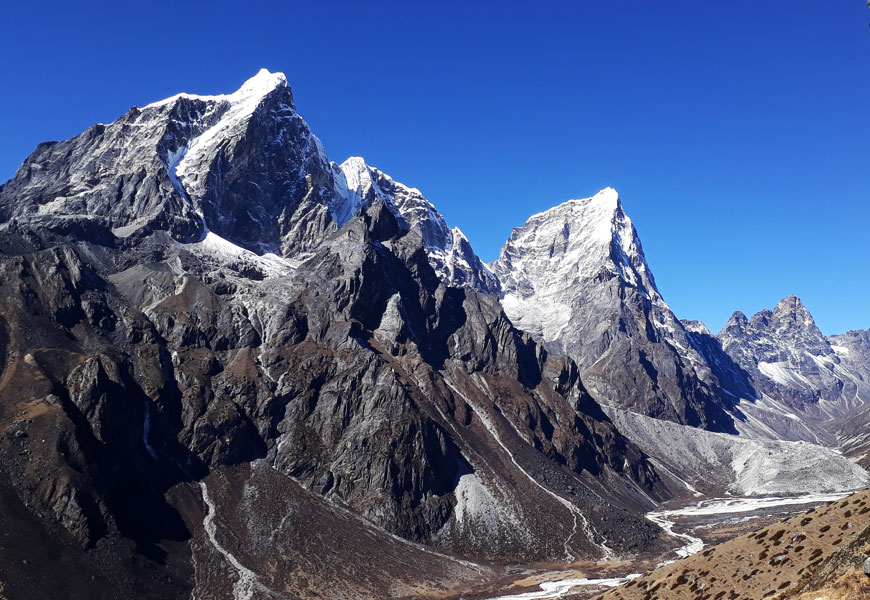
The trail, temperature, weather, and vegetation all favour trekkers during the month of September. If you are planning for Everest Base Camp Trek ( 16-Day ) during the month of September. This will be a favourable time in all aspects.
Temperature is mild with neither too cold nor warm and rain remains far away throughout the trek. As this is just the beginning season of the trek after the rainy season, you will find comfortable lodges and select rooms for a comfortable overnight stay.
Everest Base Camp Trek is a dream destination for many but some trekkers are not able to accomplish it due to the wrong choice of the month and when they do, they are troubled to find lodges and tea houses.
So, successful trekkers do the right research before they plan for the Everest Base Camp Trek ( 9-Day ). Due to excellent weather conditions during September, there will be regular flights to and from Lukla Airport, the gateway to the Everest region.
Table of Contents
Mt. everest base camp trek weather like during the month of september 2024.
September is regarded as one of the finest months of the year for Everest Base Camp Trek in all aspects. It is the end of the monsoon and the beginning of the winter season here in Nepal.
Due to excellent weather conditions, the sky remains clear and blue and the visibility is also higher.
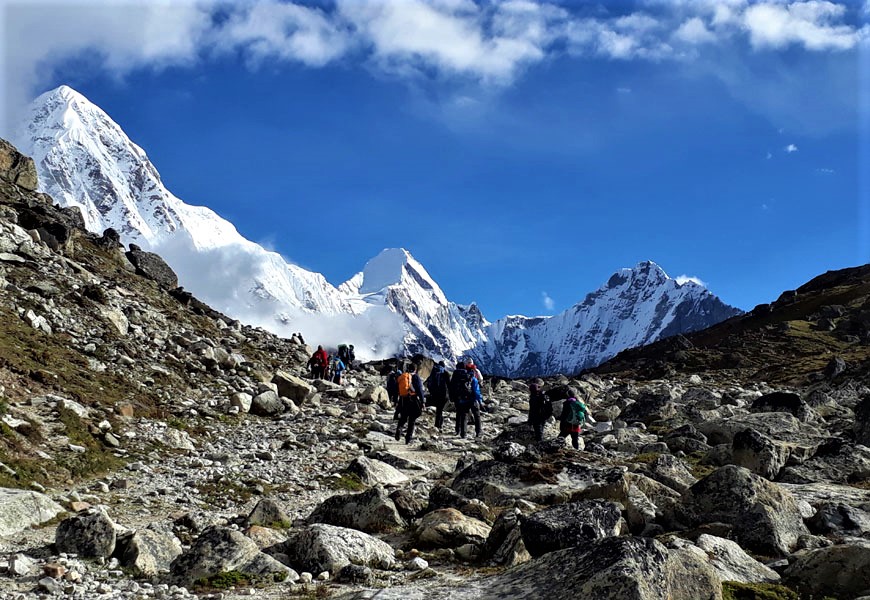
During the month of September, trails remain clean and less crowded, as this is the just beginning season of the trek and expedition in the Himalayas. You will find regular domestic flights to and from Lukla, which is the shortest gateway to the Everest Region .
Temperature is pleasant with neither too cold nor too warm, but the night temperature at the high altitude of around 5000 meters and above goes to freezing temperature (sometimes). But during the day the temperature will be around 10°C to15°C.
This makes hiking during the day lighter and easier, instead of heavily worn clothes and jackets.
Base Camp Trek Accommodation during the month of September in Everest 2024
September is the month of autumn and just the beginning of trekking and expedition season in Nepal. June, July, and August are monsoon here, this is the time when the trail remains closed and the tea house and lodges too.
During the monsoon season, trekkers skip any trek in Nepal, due to heavy downpours, and trails are not supportive and doable.
Apart from this, visibility is low and the sky remains covered with rain clouds moreover, very few flights land at Lukla Airport , the gateway to Everest Base Camp Trek.
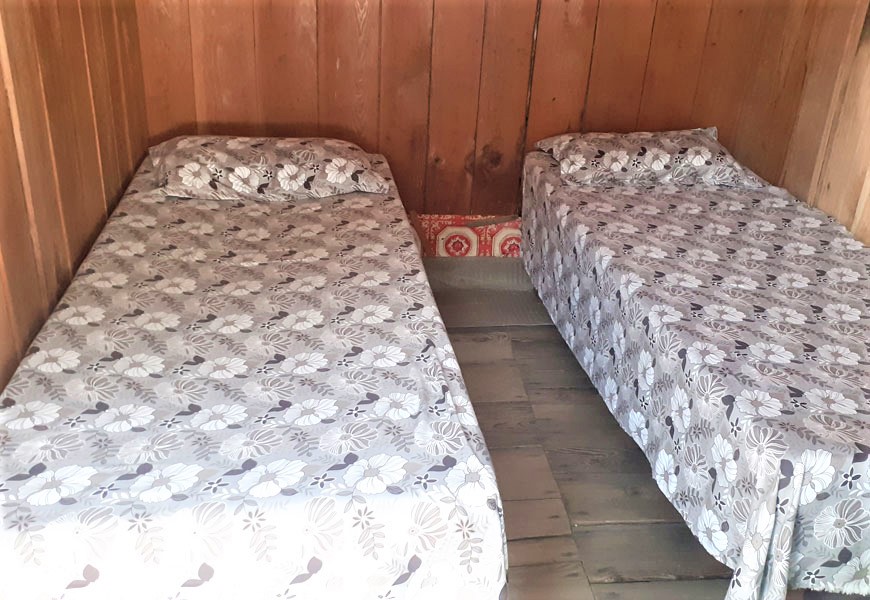
Now, September is the beginning season for trek and expedition, and all hotels, teahouses, and lodges are open. They remain clean and less crowded and you will have the option to select your lodges and a comfortable room facing the mountain views.
Due to fewer trekkers, service at the lodge and tea house is quick and faster than during the high trekking season. There is always an abundance of selective food of your choice.
At the high altitude above 3700 meters, normally tea houses and lodges will have common shared toilets and bathrooms in every hotel. So, during September you don’t need to wait to enjoy being in this place.
Cost and Crowd in the Trek of Everest Base Camp during the month of September 2024
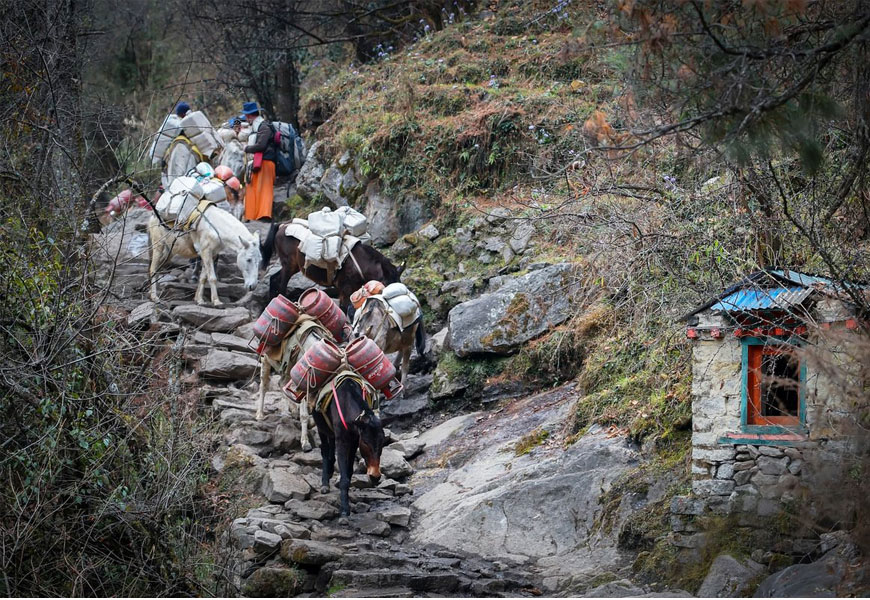
September is just the beginning time for Everest Base Camp Trek, Expedition, and High Pass Trek. This month is also the beginning of Autumn in Nepal.
After almost three months of long monsoon season, September brings high visibility of the Himalayas, pleasant temperatures, and a clear blue sky.
This time of the year will have fewer trekkers than in the months of October and November. Due to the beginning month of the trekking season, the trail will be less crowded and hotels and lodges will have sufficient numbers of rooms.
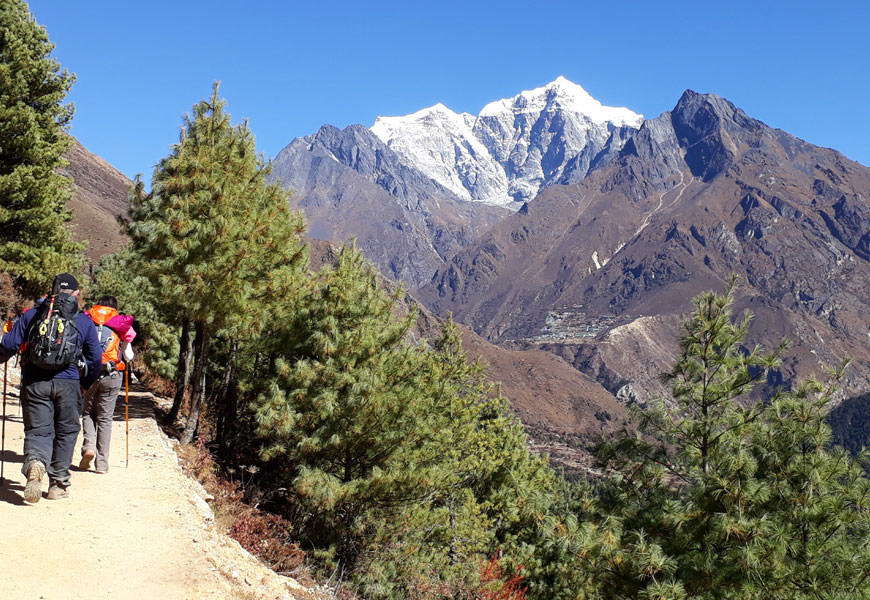
So, you will have numerous choices of lodges and teahouses along with comfortable rooms with mountain-facing views.
Now about the cost of Everest Base Camp Trek.
Lots of trekkers think that trekking will be cheaper due to remoteness but this is not true. Everest Base Camp lies in the Everest region of Nepal and in the Himalayan region as well.
There are only two ways to enter this region and the easiest and fastest is to take a domestic flight to Lukla airport. Due to extreme freezing temperatures, high altitude, and less manpower, food supplies are all carried from the city areas.
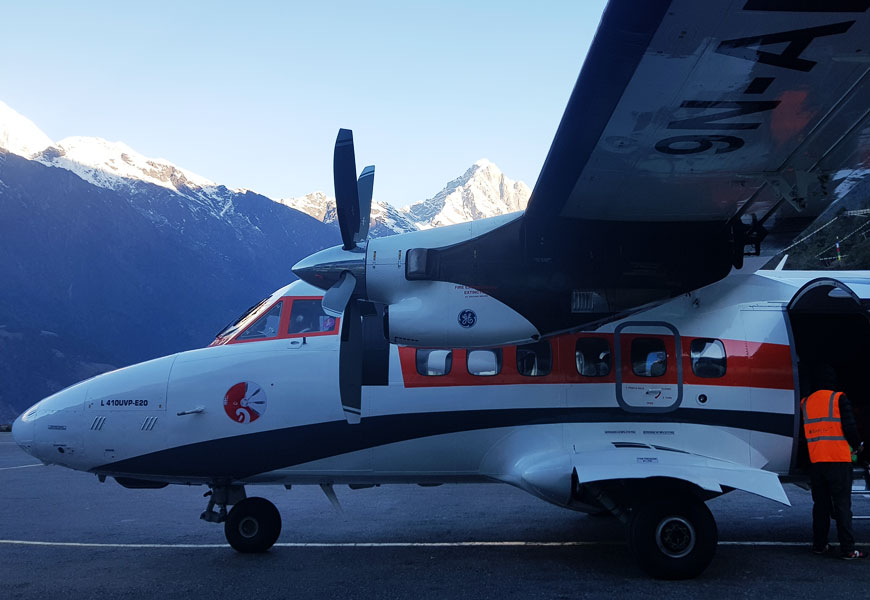
This supply is mainly fulfilled from Kathmandu and the surrounding cities and towns of the Everest region, which are supplied through flight or local transportation halfway and are carried by Mules and Yak or humans the other halfway.
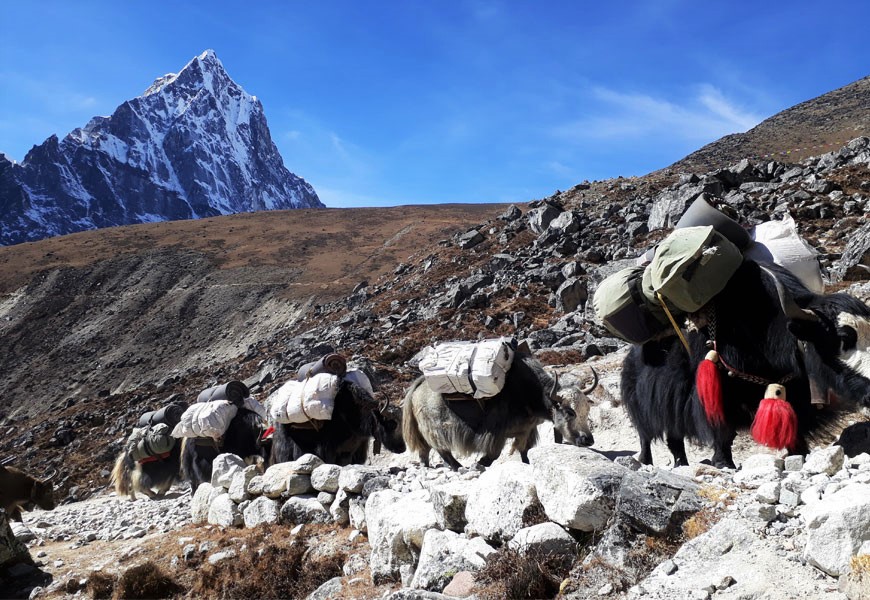
These transportation charges cost more, resulting in a hike in foodstuff and cooking equipment including vegetables, drinking water, etc.
But accommodation will be cheaper as compared to the city areas. So be prepared for the cost while trekking in the high Himalayas. As you trek higher the price hikes accordingly.
Normally, USD 60 will be enough for all your meals, accommodation, and tea/coffee, apart from the Lukla flight which will cost around USD 200, until there is a hike in air-fuel.
Highlights of the Everest Trek in the month of September 2024
September is a pleasant and doable month of the year for the Everest Base Camp Trek. This is the beginning of the autumn season, making the clouds remain clean with the blue sky. Visibility is higher as compared to other months of the year, which makes regular domestic flights to Lukla Airport, the gateway to Everest Base Camp.
The temperature is pleasant, neither too warm nor too cold, so you can hike will less stuff and gear, and wear comfortable clothes.
There will be less crowded on the trail and lodges and tea house remains sufficient with rooms of your choice.
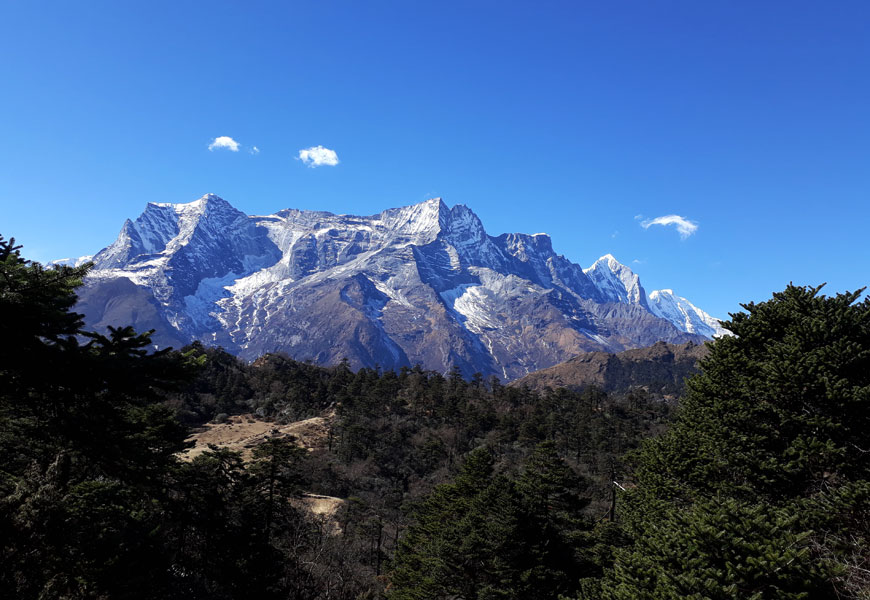
Apart from all these, you will be able to explore Himalayan vegetation, flora, and fauna. Snow leopards, bears, Himalayan Thar, and Himalayan birds will be the center of attraction.
During September locals will be actively involved in their daily activities. This makes the monasteries open and ritual ceremonies organized every day.
Apart from this, you will be able to explore the unique culture and customs of the Sherpa community, their lifestyle, and their agricultural life.
Rivers of the Himalayas will be active with the snow-melted water, and colorful praying flags all around the trail including the suspension bridge the best is to get an opportunity to meet and greet the expedition group and spend time with them on the trail and also at the Everest Base Camp.
Due to the finest weather, magnificent views of the Himalayas, and enjoying the sunrise view from Kalapatthar is something never to miss.
Festivals during the month of September in Nepal 2024
Note: The festival Date for September 2024 AD has not been officially published by the Government, will keep on updating.
September is the beginning of the autumn season and the time when festivals start. Nepal is a diverse country with around 125 different ethnic communities and speaking 123 different languages.
This diversity makes Nepal a unique country in all aspects. There are numerous celebrations and festivals in Nepal, some are based on a particular community and others are celebrated nationwide.
As Nepal is not a member of a commonwealth nation, this means Nepal was never been colonized. So, Nepal to date has its own national calendar and is stated as BS (Bikram Sambat). Now the country is in 2080 BS and this is the only official calendar of Nepal.
So, festivals in Nepal follow according to the Lunar calendar, which makes the date goes changing every year, sometimes even the month.
So, here we will talk about the festival related to the month of September 2024 AD, for this, I am taking the help of the Nepali official calendar.
In September 2024, there are different festivals and celebrations and among them, Dashain is the most popular and long-celebrated festival in the entire country. This festival starts on the 26th of September and ends on the 7th of October. Making Dashain the longest festival in Nepal.
The government officially gives a week-long holiday nationwide but the Sherpa community of the Everest region follows Tibetan Buddhism. They don’t celebrate as much zeal as the other community does.
But you can be part of the celebration if you are in Kathmandu or another region apart from the Himalayas.
Other than Dashain on the 18th of September 2024, the Jitiya Festival is celebrated with enthusiasm in the Terai region, south of Nepal, and also in Kathmandu Valley (a particular location). And on the 3rd of September 2024 is Constitution Day which is also an official holiday.
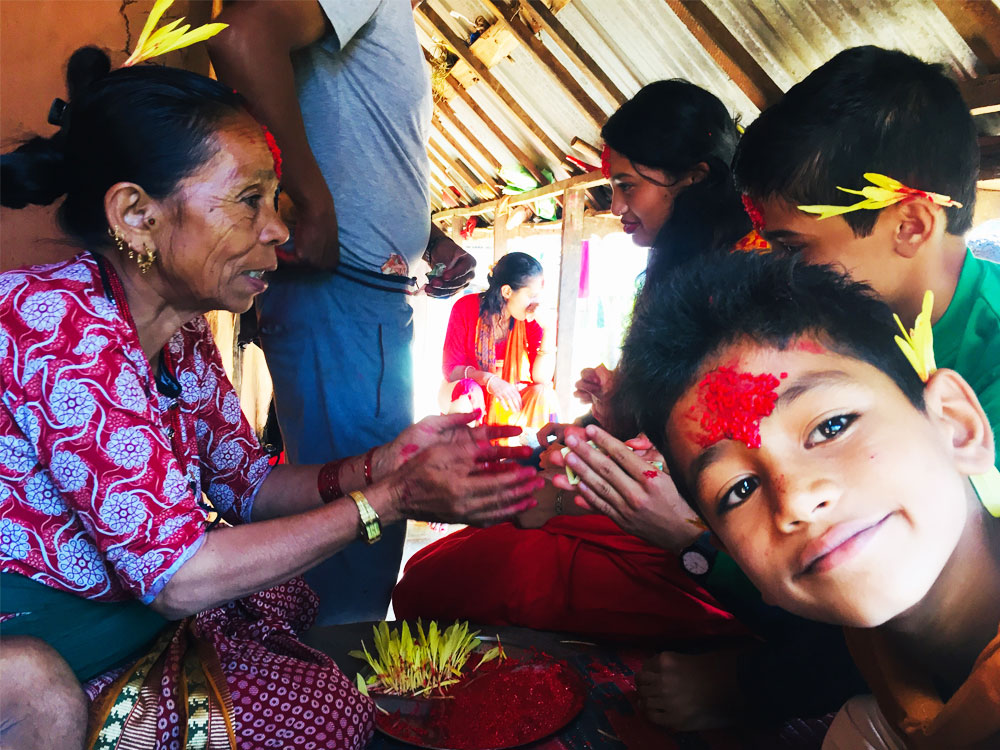
On this day army, school, and college students perform parades and different activities, and high-level officials visit the open parade ground in Kathmandu.
Other than these popular nationwide festivals in September, there will be minor celebrations of particular communities everywhere.
Alternative other routes in the Everest region during the month of September 2024
Everest itself is a diverse region and is the only UNESCO natural heritage site situated at such an altitude. Everest is the home of 4 mountains that are above 8000 Meters including Mt. Everest.
There are different trails and activities which you can enjoy in the Everest region. Starting from the short trek to the Everest region, you can go for high Himalayan treks, high pass treks, peak climbing, and of course expeditions.
This makes Everest a popular region where you can spend a couple of days to months hiking and trekking.
Apart from Everest base Camp Trek, trekkers can combine with Ama Dablam Base Camp Trek or go for Everest Three Pass Trek , Mera Peak Climbing , Island Peak Climbing , or an expedition to Ama Dablam or even Mount Everest.
If you are planning to spend long days at Everest Base Camp, you can try one way to descend through Jiri instead of a short flight from Lukla or go for Gokyo Lake and Gokyo Ri with Everest Base Camp.
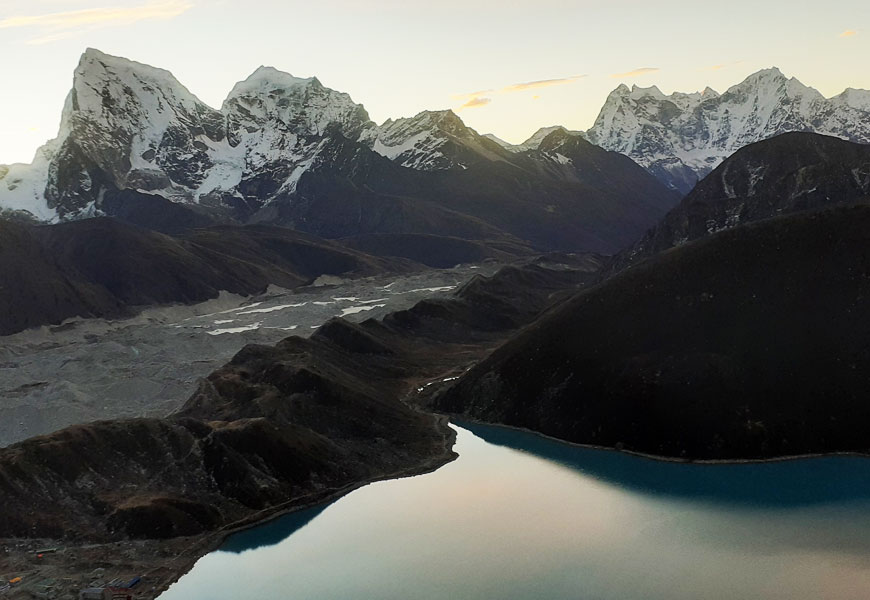
There are multiple popular trails in the Everest region, which fewer trekkers dare to try because those are challenging, more time-consuming but very adventurous.
The main reason for this exciting route trek in the month of September is favorable weather conditions. September is the finest month of the year for the high Himalayas trek, as the temperature is pleasant with rare snowfall and a high visibility rate.
This makes the trek a once-in-a-lifetime experience. For the best itinerary in Everest Region in September just click the link and choose according to your time frame or customize it according to your required standard.
Popular Everest Base Camp Trek Packages
1. 9-Day Everest Base Camp Trek
2. Short Everest Base Camp Trek
3. Budget Everest Base Camp Trek
4. Everest Base Camp Luxury Trek
5. Kalapatthar Trek
6. Everest Base Camp Trek with Helicopter Return
7. 6-Day Everest Base Camp Trek
8. Everest Base Camp Trek for Beginners
9. 15-Day Everest Base Camp Comfortable Trek
https://www.discoveraltitude.com/everest-trek
Interested in Everest Base Camp Trek: For more information or booking WhatsApp: +977-9841161593 or Email: [email protected]
- Discover ALtitude
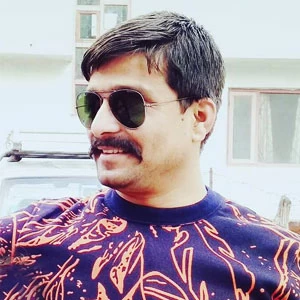
Kumar Lamsal
Kumar is one of the Co-founders and Managing directors of Discover Altitude holding 18 years of experience in the tourism sector of Nepal. He has trekked to almost all the popular regions of Nepal and is an authorized trekking and tour guide.
Started his career as a porter to support his study, now holds MPhil and LLB degree, and is doing his Ph.D. in religious studies. He loves traveling to the Himalayas and has deep knowledge about religion, culture, and history.
Kumar is also involved in the teaching sector as a part-timer to deliver his research related to the cultural and religious diversity of Nepal and is the one who mostly answers your queries giving them his personal touch through his decade-long experience.
Send us your feedback
Recent posts.
- Annapurna Circuit Trek Distance and Altitude Profile with Day to Day Itinerary
- Everest Base Camp Trek for Indian Citizens Cost and Itinerary
- Ghorepani Poonhill Trek Distance, Elevation and Weather
- Everest Base Camp Trek in February 2024-2025
- Everest Base Camp Trek Altitude With Oxygen Level | Know your minimum Oxygen Level during EBC Trek
- Hire a Trekking Guide and Porter in Nepal | Guide and Porter Cost 2024-2025
Related Posts
- Nepal Trekking Company and Tour Operator
- A Complete Visa Guide to Nepal and Fees
- Muktinath Darshan Tour Package for Indian Citizens
- Lukla Airport: A gate-way to Everest region in a fastest way
- When and where will Mount Everest Base Camp be shifted | Nepal to Relocate Everest Base Camp
- Best 10 Luxury Tours and Holiday Package in Nepal
- Festivals in Nepal
- News and Events
- Places to See
We use cookies to ensure that we give you the best experience on our website.

- You are here:
- Nepal Trekking Tips
Everest Base Camp Trek in September
- May 27, 2024
- Marvel Adventure

Table of Contents
Everest base camp trek overview.
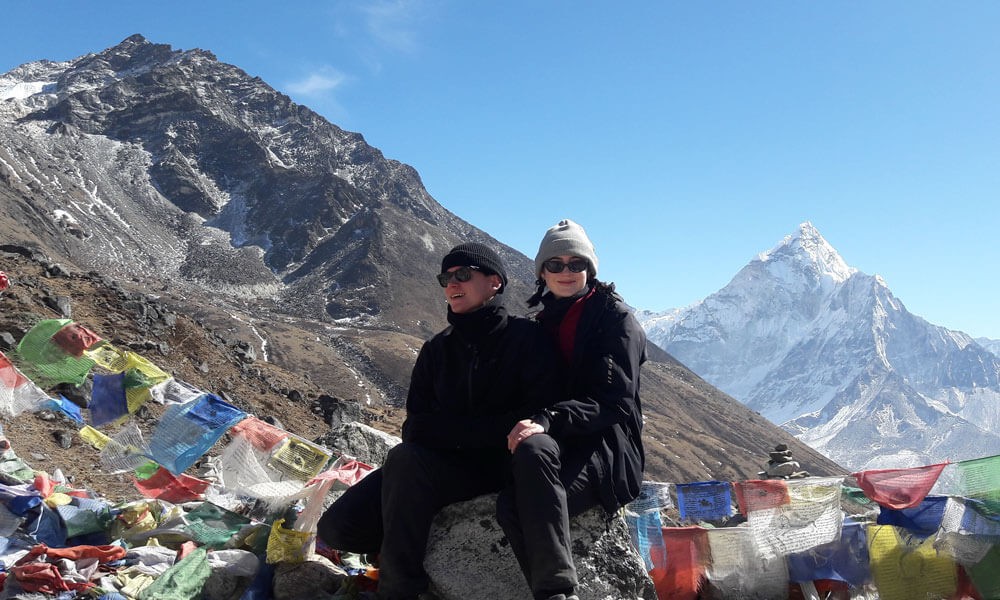
Why Everest Base Camp Trek in September?
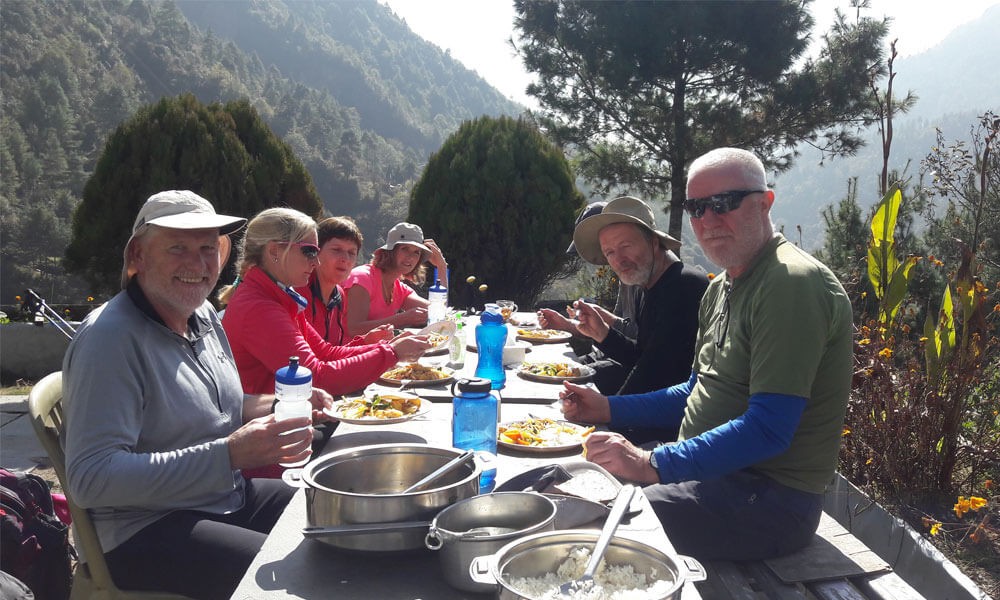
Weather of Everest Base Camp in September
Pros and cons of everest base camp trek in september.
.jpg)
Everest Base Camp Trek in September Itinerary
Packing list for everest base camp trek in september.
Sleeping Bag
When the temperature gets colder, heavyweight fleece gloves gives you extra warmth. It would be best if the glove is waterproof and durable.
Other Personal Stuffs
Your personal belonging cell / phone, good charger, walking poles, indoor games chess or similar and playing cards, reading materials, daily-note books and pens.
You need sunscreen when trekking in the high mountainous region. In the high altitude, the sun rays are powerful. So you should bring the highest SPF sunscreen for your protection.
Water Bottles
First aid Kit
- Everest Base Camp trek in July
- Everest Base Camp Trek In June
- Everest Base Camp Trek in October
- Nepal Travel Guide
- Nepal Trekking Information
- Himalaya Trekking
Send an Enquiry - Everest Base Camp Trek in September
Recent post.
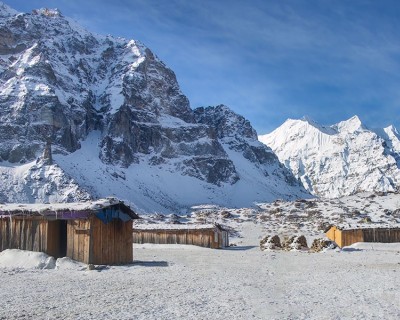
Less Crowded Treks In Nepal
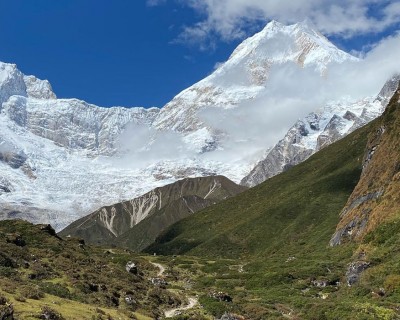
Tsum Valley, Cultural Richness & Buddhist Influence
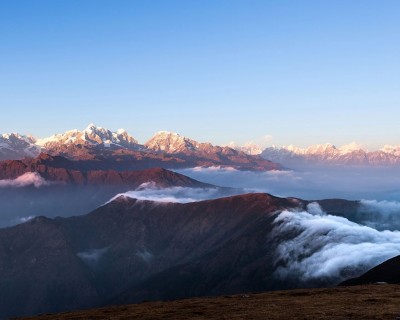
Perfect Time For Pikey Peak Trek
- Annapurana Guide - 16
- Climbing - 1
- Dolpo Trek Guide
- Everest Guide - 52
- Kanchenjunga Guide - 8
- Langtang Guide - 5
- Makalu Trek Guide - 2
- Manaslu Trek Guide - 19
- Mustang Guide - 4
- Nepal Trekking Tips - 9
- Places to see in Nepal - 4
- Things to do in Nepal - 14
- Trekking in Nepal - 12
- Uncategorized - 5
Marvel Adventure Pvt. Ltd.
Share this:
Marvel adventure affiliations & certificates, registered with: company registration office, government of nepal, licensed by: nepal tourism board & department of tourism, proud member of trekking agency's association of nepal, general member of nepal mountaineering association.

Classic EBC Trek
- EBC + Gokyo Trek
- Jiri to EBC
- 3 Passes Trek to EBC
- Island Peak and EBC
- Acclimatisation
- Packing List
Get a Trek Quote
Gokyo lakes trek to everest base camp (expert guide) .
The Gokyo Lakes Trek to Everest Base Camp is a variation of the traditional trek to Base Camp that offers additional sights and the wonderful opportunity to experience the beauty of the highest freshwater lake system in the world. This is all in addition to visiting the Everest Base Camp and high-point of Kala Patthar – two of the highlights of the standard base camp trek.
The route parts with the classic Everest Base Camp Trek at Namche Bazaar and heads west up the Dudh Koshi valley towards Gokyo Lakes and the trekking peak of Gokyo Ri. Expect quiet trails that allow you to focus on the sheer natural beauty of your surrounds – a much more varied and verdant landscape than on the classic trek.
Because of the route’s circular nature, you will not have to retrace your footsteps on the return leg of the trip as you would have done on the standard base camp trek. After spending some time relaxing at the turquoise glacial lakes you will summit Gokyo Ri only to be blown away by some of the most stunning views of Everest (8,848m), Lhotse (8,516m) and Cho Oyu (8,201m).
From there you will ascend one of the iconic ‘Three Passes’ in the region – Cho La pass – over which you will re-join with the main trek up to Gorak Shep. You will have the opportunity to visit the trekker’s photo point at Everest Base Camp before setting out on the trek up Kala Patthar the next day – another iconic viewpoint in the region.
This article covers the Gokyo Lakes to Everest Base Camp Trek by providing a detailed, day-to-day itinerary, map and by answering various questions on when to go, what to pack and how much it will cost.
Get the latest information on the Coronavirus situation in Nepal and how it may effect your travel plans.
We do not sell tours, we simply provide impartial advice . If you would like an exact quote from our recommended tour operator click Get a Quote.
Gokyo Lakes Trek
Regional map.
The trek takes place in the Everest or Khumbu region of Nepal as shown by the orange block on the map below. After flying into the capital, Kathmandu, you will take a short flight into Lukla where the classic Everest Base Camp Trek as well as the Gokyo Lakes Trek begins.

For an alternative to flying into Lukla airport, consider the Jiri to Everest Base Camp Trek – a variation which starts with a bus ride before trekking most of the way in a fashion similar to the early pioneers of the region.
Goyko Lakes Trek Map
This map provides a schematic representation of the trek to Everest Base Camp via Gokyo Lakes. After flying into Lukla, the trek starts along with the classic trek heading north through Phadking. At Namche Bazaar, the route forks left and passes through the small town of Dole and Machhermo before reaching the Gokyo Lakes in the north-west.
After the summit of Gokyo Ri is completed, the route heads east over the Cho La pass towards Tengboche and Pheriche, where it joins up with the main Everest route. From here you follow the Khumbu Glacier up to Gorak Shep and eventually Everest Base Camp. After climbing up Kala Patthar, the route descends through Dingboche on the classic trail before reaching Namche Bazaar and finally Lukla.
Recommended Guidebooks
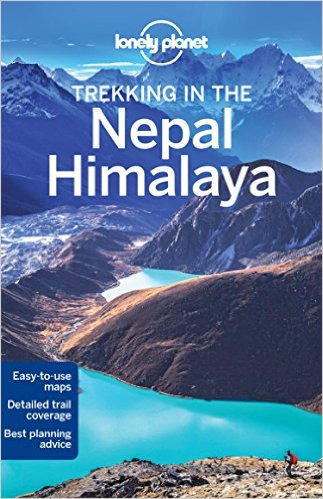
Taking a guide on the Gokyo Lakes Trek is a great way of ensuring you make the most of your time spent in the Khumbu region. The Gokyo Lakes variation is also much quieter than the classic trek, so an easy-to-read map can come in handy when navigating through the valley.
The Lonely Planet Trekking in Nepal Himalaya guide is updated regularly and is a well-known, trusted resource used by many trekkers worldwide. The guide is very detailed and contains information for many treks, meaning you can use it more than once!
For an excellent trekking map we recommend: Nepa Maps 1:50,000 Gokyo and Everest Region Map .
Detailed Goyko Lakes Trek Itinerary
As with the popular classic trek, the Gokyo Lakes Trek also starts in Lukla after a short, yet memorable flight from Kathmandu. The outward leg of the trek takes you north-west through the Dudh Koshi valley before looping around after Gokyo and returning along the classic route.
The entire trips lasts around 17 days, of which 2/3 days will be spent in Kathmandu pre and post the trek. This is a few days longer than the traditional Everest trek – accommodating the countless extra sights you will come across as you make your way to the base camp.
Day 1: Kathmandu, baby!
Arrive in the capital city of Kathmandu. If you have booked your trip with a tour operator they will usually provide airport transfers and will have arranged your hotel. If you are travelling independently there are loads of taxis at Kathmandu airport (just make sure you agree a price before you get in the taxi) and we recommend staying in the Thamel district.
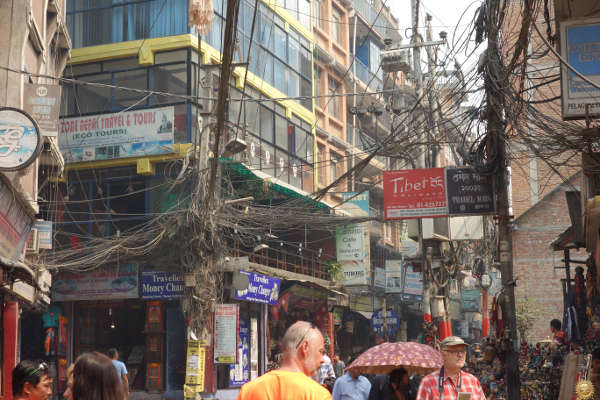
Vibrant streets of Thamel, Kathmandu
Day 2: Fly from Kathmandu to Lukla. Trek to Phadking
A short morning flight will take you to Lukla Airport. The flight is quite an experience itself so be sure to bring your camera with! After touching down in Lukla, the trek begins with a short descent to Phadking, passing various Buddhist sights along the way. Find our more about the flight to Lukla here .
Day 3: Phakding to Namche Bazaar
A full day’s trekking will take you into the start of the Sagarmatha National Park . A steep finish to the day will bring you to Namche Bazaar (3,440m), the central trading outpost of the region. Explore the village and stock up on some much-needed snacks for the next few days. Be sure to check out the weekly market if you happen to be there on a Saturday! Please note: many people split day 3 into two parts, stopping for the night in Phakding before continuing onto Namche on day 4.
Day 4: Acclimatisation Day
Spend the day acclimatizing in Namche Bazaar by exploring the area steeped in tradition. A short hike to the Everest View Hotel will give you a chance to catch your first glimpse of the famous mountain, as well as the imposing Ama Dablam.
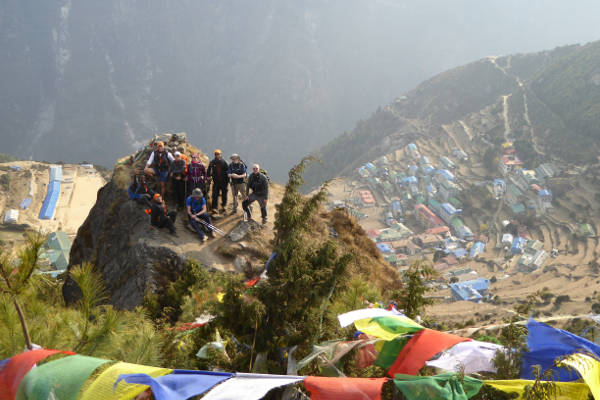
Day 5: Trek to Dole
The trek now separates from the main Everest route and heads north-west up the Dudh Koshi valley towards Dole. You should be able to snap some amazing pics of Everest, Lhotse and Ama Dablam as you cross one of the early ridges.
Day 6: Trek to Machhermo
A fairly steep day of trekking will take you up 500m in altitude towards Machhermo. Keep your eyes peeled to see some of the yaks during the summer months. Once again, you will be treated with some of the best views of Cho Oyu and the surrounding peaks as you trek. Try to keep your head up to take in some of the beauty!
Day 7: Acclimatisation Day
Your second acclimatization day will be spent at Machhermo. Use the time to seek out the views of the Ngozumpa Glacier – the largest glacier in the Himalayas.
Day 8: Trek to Gokyo
After a good day’s rest, make your way to the first of the lakes – you won’t be able to miss them with their striking turquoise water standing in stark contrast to the landscape of the region. After the third lake, you will reach the village of Gokyo where you will be staying for the night.
Day 9: Gokyo Ri and then hike to Dragnag
An early start to the day is needed for the summit of Gokyo Ri. At just below 5,500m, the summit offers wonderful views of Everest, Lhotse and Cho Oyu. Keep your fingers crossed for good weather! Descend later that morning and then cross the Ngozumpa glacier before heading to Dragnag for the night.
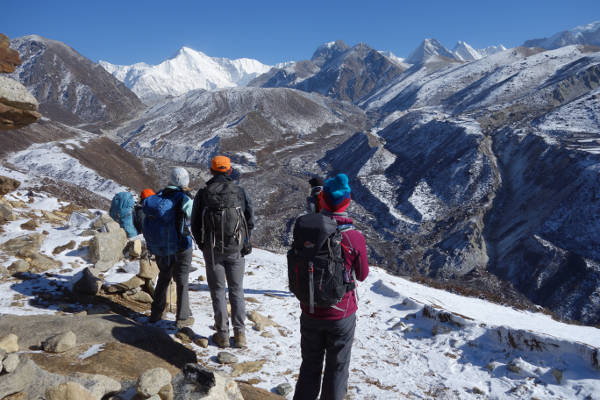
Day 10: Over the Cho La Pass and onto Dzongla
Be prepared for a long day as you traverse one of the ‘Three Passes’ – Cho La. Take your time as you tackle the rocky trail over the pass, reaching 5,420 at its highest point. From here you will cross the glacier on the other side of the Cho La and descend to Dzongla.
Day 11: Rejoin the classic trail and hike to Lobuche
Rejoin with the main Everest route as you pass through Pheriche and Tengboche, where you will find the largest monastery in the area. The trek from Pheriche to Lobuche passes many memorials to Sherpas and climbers who have died climbing Everest. You will spend the night in Lobuche.
Day 12: Lobuche to Gorak Shep (hike to EBC and back to Gorak Shep)
The day is spent hugging the Khumbu Glacier as you make your way up to Gorak Shep and eventually Everest Base Camp. Tour groups are not typically allowed to stay in base camp for long, so take the opportunity to get a feeling of the buzz and excitement of potential summiteers of Everest (if you visit during the climbing season – April / May). Descend back to Gorak Shep for the night, passing great views of the infamous Khumbu icefall.
Day 13: Ascend Kala Patthar and then hike to Dingboche
Ascend the trekking peak of Kala Patthar for more breath-taking views of Everest and the surrounding peaks. Descend that afternoon to Dingboche, following the classic route.
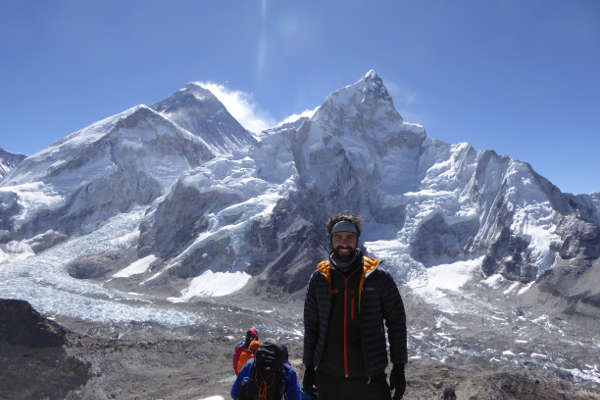
View from Kala Patthar with EBC, the Khumbu Glacier, Nuptse and Mount Everest in the background
Day 14: Return to Namche
Descend back to Namche Bazaar via Tengboche. Keep your camera on you as you pass through the rhododendron covered slopes – making for a great photo.
Day 15: Hike to Lukla
Finish the trek with the descent to Lukla, through the Dudh Koshi valley. Catch up on some much-needed rest and possibly a few drinks to celebrate what is sure to have been a memorable trip!
Day 16: Fly back to Kathmandu
Fly back to Kathmandu early in the morning.
Altitude Profile
This chart shows the altitude profile of the typical Gokyo Lakes to Everest Base Camp Trek, starting in Lukla and reaching the high-points of Gokyo Ri, Cho La Pass and Kala Patthar.
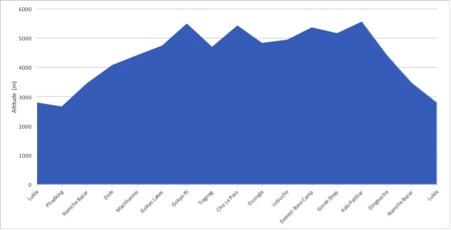
A significantly greater part of the trek is spent above 4,000m when compared to the traditional Everest Base Camp Trek. The ascent profile is also steeper than the traditional trek – contributing to the increased difficulty of this variation.
Gokyo Lakes Trek FAQ
How much does the gokyo lakes trek cost.
The Gokyo Lakes to Everest Base Camp Trek tour package tends to cost £400-£500 more than the classic Everest Base Camp Trek – mainly because the trek is longer, therefore requiring more accommodation, food and guides.
Trekking independently is not recommended for this variation because the routes are much less busy and the trek in general is more challenging. A tour operator will organise all accommodation, food, permits and communal equipment as well as provide well-trained guides. Packages will cost in the region of £1,200 to £2,500.
Read our detailed article on the breakdown of costs for the classic Everest Base Camp Trek here .
When is the best time to trek the Gokyo Lakes route?
As with most treks in the region, it is best to avoid the peak of summer when the monsoon season is at its zenith by trekking in the shoulder months either side of it. During these months, the weather tends to be stable and dry – making for good trekking and sightseeing conditions.
The pre-monsoon months of February to May are a popular time when the mountain is at its greenest. September to October are considered the best months to trek on the other side of summer.
Trekking during peak season should not be much of an issue on the Gokyo Lakes to Everest Base Camp trek as the route avoids the crowds of people tackling the classic trek.
Find out more information on weather and the best time to trek in the Everest region .
How difficult is the Goyko Lakes trek?
If the classic Everest trek is considered an easy trek, then the Gokyo Lakes variation may be considered moderate. While no previous trekking experience is required, the trek does involve 5-7 hours of trekking per day on hilly/rocky terrain at high altitudes. Much of the trek is spent above 4,000m and altitudes of over 5,500m are reached when traversing passes and trekking peaks.
We do recommend training a few weeks to months beforehand so that you will be comfortable walking similar distances on the trek. Here is our EBC trek training guide .
Will I get altitude sickness?
The itinerary of the trek is designed to provide enough time for the body to acclimatize to the high altitudes. If you follow the guide and don’t rush the ascents, you should be fine. Most high-points on the trek are peaks or passes which will be descended shortly after reaching the top – following the principle of ‘climb high, sleep low’.
Altitude sickness can affect anyone, regardless of fitness or age, so it is still vital to read up on the symptoms and different variations of the condition. Our detailed article on acclimatization and altitude sickness is sufficient reading preparation for the trek.
What gear should I pack for the Gokyo Lakes Trek?
The packing list for a trip of this length is quite extensive, so we have compiled an article that details what you should bring and which brands offer the best value for money.
Read the Everest Base Camp packing list for our recommendations based on past experience of trekking in Everest.
What insurance do I need?
The short answer is yes. Trekking in Nepal at high altitudes comes along with various risks that are not covered by typical travel insurance. We recommend taking out insurance that covers trekking to altitudes up to 6,000m as well as medical evacuation from the mountain.
We have a detailed article to help to find the best policy that will suit your needs. Alternatively, use the quote calculator below from our recommended partner, World Nomads. They offer insurance that covers guided hikes up to 6000m and include a premium for Helicopter Evacuation in Nepal.
Route Variations
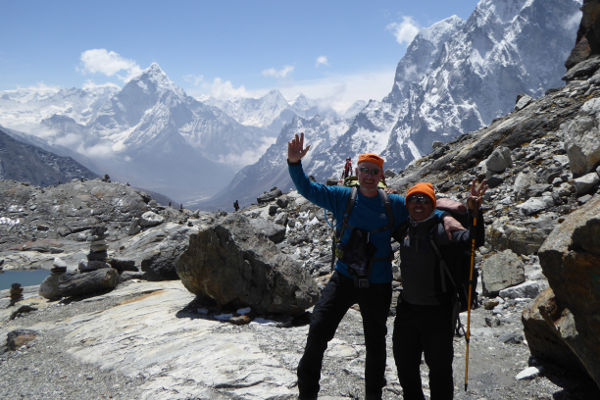
The most popular trek in the region, the classic Everest Base Camp Trek starts after a flight into Lukla. From there the hike begins with gradual ascents each day through various villages and small towns as you head north through the Khumbu Valley.
The trek takes you through the villages of Phadking, Namche Bazar, Tengboche, Pheriche and Gorak Shep before reaching the Everest Base Camp. You then retrace your footsteps as you head back down the valley, using the same route.
The trek is very popular during peak trekking season with over 30,000 people completing it annually. It typically lasts 14 days and covers 130km of trekking that involves covering an average of 15km per day over 5/6 hours.
Three Passes Trek

The Three Passes Trek is a tougher variation than the classic Everest Base Camp Trek because it involves crossing three very high passes as well as summiting some walking peaks which are not included on the classic trek.
The variation starts by following the classic trek from Lukla to Namche Bazar before veering west towards Thame and the remote Nangpa Valley. The first of the three passes encountered is the Renjo La, where you will be afforded magnificent views of Everest before descending to the idyllic Gokyo lakes.
The next pass, Cho La, involves walking up a fairly steep and icy trail before reaching a small glacier at the top. From here, you descend and re-join the main base camp trek where you summit Kala Patthar – the iconic viewpoint. You continue onto base camp itself before descending to Lobuche.
You then head east over the third pass of Kongma La and continue onwards to summit the third peak of Chukking Ri. Once again you will have amazing views of the surrounding peaks that you would not get to see on the classic trek. The circuit is completed by returning to Lukla through the main Everest trail.
Jiri to Everest Base Camp

This variation of the classic trek offers an alternative to flying into to Lukla from Kathmandu to start the trek. The Jiri variation starts with an 8-hour bus ride from Kathmandu to Jiri, where the trek begins.
The variation adds an extra 5/6 days onto the trip as you trek through the Solu-Khumbu region and make your way past Lukla, where the trek then follows the same route as the classic Everest Base Camp Trek.
It involves a scenic, yet very long, bus ride as well as a lot more exposure to the Tibetan and Sherpa cultures. Expect to trek through more forests and streams as you start at the relatively low altitude of 1,800m and work your way up to Lukla and beyond.
Island Peak Climb

The variation trek that involves summiting Island Peak is significantly harder than the classic Everest Base Camp Trek. The climb to the peak is somewhat technical although and requires basic knowledge of using crampons and ice axes. Standing at just under 6,200m, however, altitude can be the real challenge.
Most climbers of Island Peak use the traditional base camp trek as a means of acclimatising before heading to the Island Peak Base Camp via Dingboche on the main trail, or by traversing the Chongma La pass. Summiting from the base camp typically takes two days and the whole variation will add around 4 days onto the classic trek.
Tags: Gokyo Lakes Trek, Trek to Gokyo Lakes, Gokyo Lakes Trek to Everest Base Camp, Gokyo Lakes Trek Map
Mark Whitman
Hi, I'm Mark! Welcome to EBC Trek Guide - the Web's No.1 Trekking Guide to Everest Base Camp. I have trekked all over Nepal, but the Everest region remains my favourite. I hope you find all the answers you are looking for on this site. If you have any questions don't hesitate to drop a comment below! Happy Trekking!
Leave a Reply
Your email address will not be published. Required fields are marked
mark you are pictured with a guide, he was my guide to Gokyo Ri in 2016, but Ive lost his contact details can you remember his name please. I lives with is family in a tea shop about half way between Lukla and Phadping
Hi Ray, his name is Pimba. All the best!
Hi Mark, lots of good info on your site. Thank you. I am 53 and planning to do the Gokyo Valley Trek returning down the Eastern side of the valley in November with my 17 year old son. We have done hikes of up to 7 days in NZ but never at altitude. I have starting a training program but a little concerned about the difficulty of this trek. We will take it slow and have lots of rest days however and get to Gokyo in 7 or 8 days before returning. Any other tips ?
Hi Emma, you both sound fit and more experienced than the average trekker in Nepal. As long as you take a slow ascend to Gokyo you should be absolutely fine and have a blast. My only tip would be to take yak tracks for the Cho La pass. It can get quite snowy in November so additional grip is never a bad thing.
Hello Mark,
We are planning to do Jiri to Ebc with the Gokyo Ri and Cho la pass. We would like to start from Jiri around the last week of february. Do you think the Gokyo ri and Cho la pass will be open and safe when we will be there? Also, we want to buy or rent a third layer in Katmandu. Do you have any shop you would recommand?
Thank you very much for all the informations and the advice,
Hi Cedrik, Gokyo Ri and Cho La should be open around this time – as long as there isn’t a late massive snowfall in late Feb / early March. In terms of gear, there are loads of gear shops in the Thamel district of Kathmandu – just make sure you avoid bad ripoffs – these will fail on the trek.
Hey Mark, Great web site! My son and I are considering the Gokyo Lakes route. We went up Kilimanjaro last year and the only altitude effect I experienced was loss of appetite. Although the quality of food was not the issue, I’d like to take food quality out as a factor I have to worry about. Hence I’m leaning toward trekking companies that cook their own food and provide boiled water. Am I being too squeamish?
Hi Jim, most trek operators use teahouses, where food is prepared by the teahouse proprietors for trekkers. teahouses on all Everest trails are pretty good nowadays. Most offer a wide and varied menus. Trek companies arrange your stays at each teahouse and will provide purified water. To find our more about teahouses see here: https://ebctrekguide.com/teahouses-on-the-everest-base-camp-trek . Cheers!
HI There. I was thinking of taking the Gokyo Lakes trek from Lukla to Dhole and Gokyo and then take the extra step ChoLa Lobuche and Everett Base Camp. When you say hug the Khumbu Glacier – is this a dangerous hike or if we are fit and have hiked before, is this something that is doable or do we need to be experts in hiking glaciers. Also how many extra days should I be thinking of if we decide to do the extra route? Thanks!
Hi Donna, the hike is not particularly dangerous, apart from altitude sickness risks, but there are areas where more caution should be taken. For example, crossing the Ngozumba glacier and the Cho La Pass comes with more risk than other areas of the hike. I would recommend taking 3-4 days more to do the Gokyo Lakes trek (i.e. 17-18 days in total).
Whether is it advisable to do first EBC and then Go Kyo Ri i.e. anti-clockwise instead of conventional Go Kyo Ri first and then EBC later?
Hi Hermant, I prefer the anti-clockwise approach as their is more time to acclimatise, but many people follow a clockwise route too. My advise would be to do an anti-clockwise route though.
We are both retired .age 71( male) n we intend to trek in sept 2022 when Cov 19 is expected to be over to the Gokyo lakes to EBC then back to Lukla.WE are regular Hills n Mtns hikers 2-3 times per week since 2018 n we r good walkers n fairly fit.Which route do U suggest is a better n easier route:1) Namche Bz to Dole,Machhermo,Gokyo Lakes,Gokyo Ri,Chola pass,Dzongla,Lobuche,Gorakshep-EBC then Kala Patthar to Pheriche,Tengboche n back to Namche Bazar or 2) Nche Bz -Tengboche,Lobuche-EBC then Kala Patthar -Dzongla,Chola Pass,Gokyo Ri & Lakes,Machhermo,Dole backtoNamch Bzr. What is the difference in terms of Days N cost? our Group :2 persons aged 72 & 2 persons below 50 years ( regular hills hikers & fairly fit)T.Q
Hi, I have only done the clockwise route from Namche to Dole etc. Personally, I think this is a better route as you get lots of acclimatisation in before getting to EBC (i.e. hiking Gokyo Ri and Cho La). There is no difference in terms of days and cost. Hope this helps!
Hi Mark, its pretty much a year to the day when I'm going (along with my wife). I want to record the hike (Strava). Is this fairly straight forward (with a phone), rather than using anything too expensive? I cannot find that much information about recording via Strava. Perhaps others aren't as sad as me..! Thanks, John
Hi John, I’ve never used Strava. But in principle if you can maintain an internet connection or a way to track offline when there is no internet, I don’t see why it wouldn’t track. Hope you’re able to do it!
Get a quote from the best local trek operator in Nepal!
Get my recommendations on the Best EBC trek operators

IMAGES
VIDEO
COMMENTS
As the monsoon rains die down by mid-to-late September, the conditions are right for trekking in Nepal again. Although lingering humidity may obscure some mountain vistas, there's still a chance to catch impressive views early in the morning. ... The classic Everest Base Camp trek (EBC), shorter treks to Namche Bazaar and around, or the Gokyo ...
In September, the weather in the Everest Base Camp region is generally favorable for trekking. Here's a detailed look at the conditions: - Temperature: Daytime temperatures range from 15°C to 20°C (59°F to 68°F) in lower altitudes and can drop to -10°C (14°F) or lower at higher elevations.
The EBC trek in September is pleasant time to visit. Though, you may not encounter lot of tourist along the route in this time of the year. The normal temperatures fall below 0°C only in higher height above 4200 M or closer to Everest only at evening & morning. In September, the average low & high temperature of Tengboche is 5°C to 12°C.
The Everest Base Camp trek in September has both the elements of monsoon and the autumn. In the first few weeks of the month, the monsoon rain is still prevalent and as so you may experience a few unexpected downpours. The average temperature during the day is warm in the lower areas of the trek with an average of 15 to 20 degree Celsius.
The temperature at night can drop even to zero degrees or below. The temperature at Everest Base Camp in September ranges between 8 to 15 degrees in the daytime, while the nighttime temperature ranges between 7 to -1 degrees. Note: Get some warm clothes for nights for your EBC trek in September.
EBC trek in September is favorable for those who don't mind a bit of chilliness during their trek. The weather at Everest Base Camp is mild during the day but cold at night, with temperatures dropping to zero degrees or below. In September, the daytime temperature ranges from 8 to 15 degrees Celsius; at night, it ranges from 7 to -1 degrees ...
For a complete cent-by-cent cost breakdown of our trek to Everest Base Camp in 2020. Cost of trekking to EBC in different ways in a nutshell: Package tour EBC trek with international agency $1700. Package tour EBC trek with local agency $1600. Independent EBC trek with a guide and porter $1370.
Jiri to EBC Trek in September. The classic Jiri to EBC Trek is a route with a twist. It starts from the lower altitudes of Jiri, unlike the trek that starts directly from a high altitude in Lukla. It is called a classic route as it is the original route to the Base Camp of Mt Everest before the Lukla airport was built.
Everest Base Camp Trek in September promises pleasant weather and crystal-clear views of the mountains. It is also the time when locals celebrate some important festivals. After months of inactivity, the trail is abuzz with trekkers, and local shops and teahouses start doing good business again. ... Pros of trekking to EBC in September. The ...
ELEVATION GAIN/LOSS | +/- approx 7600 metres (Classic EBC Trek incl. acclimatisation/day hikes) MAX ALTITUDE | 5611 m (Kala Patthar) ... September and mid-November to December. During these times it can be much quieter on the trail. There is typically cold weather in March and December. In March there is a high chance of lingering or fresh snow.
Weather of Everest Base Camp Trek in September. One of the best things about Everest Base Camp Trek in September is its weather. The weather during this month is very favorable for trekking in the Himalayas. It is neither too hot nor too cold. The skies are clear and humidity-free during this time of the year.
Awesome Weather. September is the transition of two seasons ie. Summer and Autumn. In this month weather becomes so pleasant that means neither hot nor cold which makes your Everest base camp trek more memorable. You may experience a light rainfall in the early days of September but after the weather becomes clear that gives a fabulous view of the mountains and surroundings.
Temperature: The temperature ranges around 10°C to 20°C. Estimated hours of daylight: In October, the average daylight hour is 8 to 9 per day. Wind: The average daily wind speed in October is around 8-11 km/hr (around 5-7 mph). The humidity is high as well. October is the best time to do the Everest Base Camp trek.
Insurance for the Everest Base Camp trek. The Everest Base Camp trek is a high-altitude trek through remote areas of Nepal. If you have serious altitude sickness or other serious medical problems in difficult-to-access like EBC or the Annapurna Circuit trek, it's highly recommended to have travel insurance that will cover you for the whole period of your trek, evacuation by helicopter might ...
There are two distinct seasons for trekking to EBC. The best months to trek to Everest base camp are in the pre-monsoon season through March, April, and May, or in the post-monsoon season from late September, October, November. If you decide to trek on the border of the monsoon season keep in mind that sometimes the season starts earlier or ...
Hiring a Guide and Porter for EBC Trek in September. The beginning of September is still pretty much off-season so it should be relatively easy to hire a porter or guide on arrival in Lukla. Towards the end of the month, many more trekkers will be arriving, and demand will be high.
Day 09: Trek from Lobuche to Gorakshep (5181 m/16990 ft.) and then to Everest Base Camp (5364 m/17594 ft.), and descend to Gorakshep again - 8 hours. Overnight at a guesthouse. Day 10: Trek from Gorakshep to Kala Patthar (5545 m/11283 ft.) and back, then descend to Pheriche (4210 m/13810 ft.) during the day - 7 hours.
The iconic Everest Base Camp Trek leads you through the Khumbu Valley, allowing you to experience the immense beauty of the surrounding Sagarmatha National Park while simultaneously providing breath-taking vistas of 4 of the 6 highest peaks in the world - My. Everest (8.848m), Mt. Lhotse (8,516 meters), Mt. Makalu (8,470 meters) and Cho Oyu (8,201 meters).
Mount Everest Base Camp Trek in the month of September 2024-2025. Notice: Nepal bans solo trekking for foreigners, which came into effect on 1st April 2023. September is the beginning of Autumn in Nepal and the start of winter. This time of the year is the beginning of trekking and expedition season as well.
Here is my Everest Base Camp trek blog with a blow-by-blow account of each trek day. Everest base camp Trek Blog Day One: Kathmandu to Phakding. My Everest Base Camp Trek Blog starts very early on Day One in Kathmandu. You quickly learn that the best weather of the day for Everest Base Camp trekking is first thing eg 5 or 6 am.
Everest Base Camp Trek Weather information for 12 months: Jan, February, March, April, May, June, July, Aug, September, October, November and December. ... The minimum temperature during the EBC Trek during March tends to be about -10 C, while the maximum temperature hovers at about 15 to 16 C during the daytime. In terms of the best trekking ...
Everest Base Camp Trek in September is a nice and pleasant walks on quiet trails than on busy peak time of trekking season, with less number of people where you can choose best lodges at your disposal. The area around high hill are alive with fresh green vegetation walking on blankets of miniature low ground flowers, where you can catch the ...
This chart shows the altitude profile of the typical Gokyo Lakes to Everest Base Camp Trek, starting in Lukla and reaching the high-points of Gokyo Ri, Cho La Pass and Kala Patthar. A significantly greater part of the trek is spent above 4,000m when compared to the traditional Everest Base Camp Trek. The ascent profile is also steeper than the ...